《英倫霸主2》(LORDS OF THE REALM 2)原版+資料片附XP,Vista兼容修正補丁[光盤鏡像] 簡介: 中文名稱 : 英倫霸主2 英文名稱 : LORDS OF THE REALM 2 游戲類型 : SLG 策略游戲 資源格式 : 光盤鏡像 版本 : 原版+資料片附XP,Vista兼容修正補丁 發行時間 : 1996年10月31日 制作發行 : Developer Impressions Games Publisher Sierra Entertainment 地區 : 美國
電驢資源下載/磁力鏈接資源下載:
- 下載位址: [www.ed2k.online][英倫霸主2][LOTR2原版].L2VER103E.iso
- 下載位址: [www.ed2k.online][英倫霸主2][LOTR2.Siege.Pack資料片]L2SIEGE.iso
- 下載位址: [www.ed2k.online][英倫霸主2][LOTR2安裝工具.兼容XP和Vista]LOTR2.Run.in.XP.Vista.Patch.NoCD.rar
- 下載位址: [www.ed2k.online][英倫霸主1].Lords.Of.The.Realm.1994.Impressions.Games.zip
- 下載位址: [www.ed2k.online][英倫霸主3].LORDS.OF.THE.REALM.3.[FullRip].rar
- 下載位址: [www.ed2k.online][英倫霸主2]Lords.of.the.Realm.2.zip
- 下載位址: [www.ed2k.online][英倫霸主2]Lords.of.the.Realm.2.-.Siege.Pack.zip
全選
"《英倫霸主2》(LORDS OF THE REALM 2)原版+資料片附XP,Vista兼容修正補丁[光盤鏡像]"介紹
中文名稱: 英倫霸主2
英文名稱: LORDS OF THE REALM 2
游戲類型: SLG 策略游戲
資源格式: 光盤鏡像
版本: 原版+資料片附XP,Vista兼容修正補丁
發行時間: 1996年10月31日
制作發行: Developer Impressions Games
Publisher Sierra Entertainment
地區: 美國
語言: 英文
簡介:
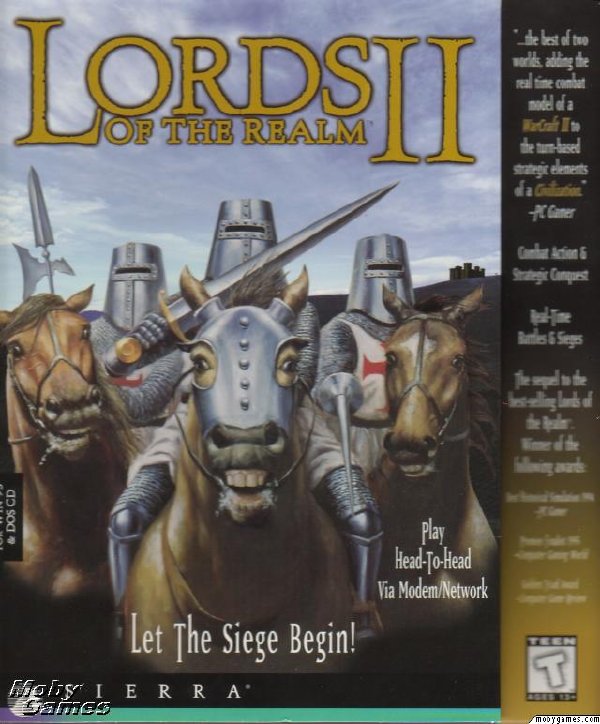
1代和2代網上已經絕版,3代電驢上有。
1代和2代算是策略經營游戲,到了3代基本就是RTS了
這裡發布二代值得重玩的經典。
英倫霸主, 原本惡名昭彰的Impressions公司, 憑這個1994年的作品來個鯉魚翻身, 得到玩家的應同讚賞. 整個游戲跟光榮的策略游戲頗相近, 玩者先要選擇一個貴族, 在自身的領地上努力經營(這包括牧羊放牛採礦筏木築城鑄劍徵兵...比三國志還要復雜), 富國強兵一番後便可到處征伐, 統一帝國. 對於喜愛在光榮游戲中當農夫的玩者來說, 因為英倫霸主在經營上很有深度, 所以玩起來或許會比三國志有更多的樂趣.
這裡是最經典的2代,游戲類似文明+全戰的融合。
說它是一套集大成之作,一點都不為過:它有《三國志》開疆辟地的成就感,有《危城爭霸》 攻城掠地的挑戰性,有《模擬城市》的經營哲理,又擁有《魔獸爭霸》的策略應用。
相信不少人都在找這個~~絕版送給懷舊的你
一、游戲簡介
這是一款由Sierra公司推出的新型態即時戰略游戲。游戲平台為Win 95。這是一個以中世紀 為背景的策略游戲。公元1268年的英國正處於群雄割劇的動亂中。此起彼落的戰火,把金黃 色的麥田染成一片血紅,將寧靜安詳的牧場燒成一片荒地。饑民們仰望著蒼天,期盼一位英 雄來結束這個充滿戰亂時代,統一這塊土地,一場中世紀歐洲大戰由游戲很好地重現。這款 游戲巧妙地將各類曾以在市場上大受歡迎的戰略、策略、經營及模擬類游戲融合在一起,說它是一套集大成之作,一點都不為過:它有《三國志》開疆辟地的成就感,有《危城爭霸》 攻城掠地的挑戰性,有《模擬城市》的經營哲理,又擁有《魔獸爭霸》的策略應用。游戲開 始也是先進行治理和建設,然後組建軍隊,攻城掠地,天下一統,但該游戲在許多方面又有 較新鮮的變化,確有其獨到和創新的地方,不會讓人覺得是在抄襲,反而有相得益彰之感。 戰斗畫面在486上就有SVGA的表現。人物動作流暢、生動,精致地刻劃出冷兵器戰爭的場面 。人工智能比同類游戲有了長足的進步,敵人也會行軍布陣,避實擊虛。
游戲是回合與即時模式並用:當治理國家大事與處理外交事務時采取回合制,可讓人謹慎地 處理各項事務,不至於手忙腳亂;進入戰斗後,在兩軍短兵交鋒時采用即時模式,不失游戲 緊張刺激的氣氛,惟在即時戰略模式時,敵人的人工智能似乎不是很強,我方部隊裡,只要 有足夠的弓箭手做後盾,再配合地形地物的利用,即便敵方部隊人數優於我方,要取得勝利 亦非難事。但由於游戲另有連線功能,若與朋友進行對戰時,其可玩性可就大大提升了。
游戲畫面采用高解析模式顯示,美工的表現極為不錯,游戲地圖並不是只限在古英倫帝國或 歐洲,而是連非洲或中國都可選擇。游戲要求的配備不是很高,在486機上進行游戲,也能 有讓人滿意的流暢度。
雖然這款游戲結合了各游戲的優點,但在操作界面上卻不若想像中的困難,即便是新手,應 該也可以很快地玩得得心應手。
就整體而言,這還是一個相當值得玩的游戲,尤其是簡化後的游戲進行方式,不需要費太多 腦筋在各種繁復的數字上,明快的游戲節奏,給人一種耳目一新的感受。
二、完全攻略
操作
進入游戲後可選擇Sigle player,然後進行新游戲(New),再輸入名字,選擇一個陣營就可 以來到美麗的英倫大陸。
屏幕左邊的大塊地圖就是游戲主畫面,在這裡可看到村莊、田地、城堡、部隊、牧場、礦場 、樹林和鐵匠鋪。在上面點擊鼠標右鍵會出現簡單的信息,只要點一下信息框右下角的箭頭 按鈕就可以關閉這條信息。
在主畫面上鼠標左鍵是重要的操作鍵。當點擊村莊時,將出現農民工作情況的詳圖,全圖分 9塊,左上是采石場或鐵礦場,依實際情況而定;左中部是開發荒地;左下是鐵匠鋪;中上 是種地;正中是無事可做的人,如果在此雙擊時以把人力最大限度地分派到農業生產中去;中下是伐木,如果在領地上沒有樹林,這裡就不會有工作的人;右上部分是放牧;右邊的和 間部分和右下部分是建造城堡。你可以用鼠標框起一些人,放到工作需要的地方,以此來改 變發展的重心。同時不要讓人閒著,也不要缺少人手的地方(閒人是灰色的坐著的人,而缺 人的地方會有一個直立的黑色人影)。
用左鍵點擊某個工作場面時,就會出現鐵匠鋪的內部細圖,牆壁上掛的是可制造的武器,選 擇一個(點擊一下),它就會放在桌上,表示當前正在制造該武器。在下方還會有一些信息, 諸如有幾個鐵匠,每季度耗費多少木材,多少鐵,能造出多少武器等。
當點擊田地時,會出現土地利用的詳圖。下方有三個按鈕,第一個按鈕表示將此塊地閒置不 用;第二個按鈕表示種糧食;第三個按鈕表示放牛。可根據實際情況來調整每一塊土地的用 途。
在點擊鐵匠鋪、伐木場、鐵礦場和采石場時,可讓他們暫停或開始工作。
當點擊部隊時就會出現一條線,將鼠標移到目的地按一下就表示部隊開拔。如果目的地是敵 人的部隊,就會開展一場野戰。如果是敵人的城堡,就會發生一場攻城戰,並會出現攻城器 械的制造窗口,可以制造發石車、雲梯和攻城車。按上下箭頭可增減器械的制造數目,決定 後按“進行”(Proceed)按鈕。經過一段時間的制造、完工後就可開戰。
用鼠標右鍵點擊部隊時,會出現部隊的控制窗口,或者當你在城堡資訊窗口中按中間的向右 箭頭也能進入駐防部隊的控制窗。窗口的上半部顯示該部隊的詳細資料,下面有三個大按鈕 ,第一個按鈕可以理解為移動,而對城堡裡的部隊來說就是出城;第二個按鈕是解散,如果 組建該部隊的母城還在,那麼所有人將回到本省去,否則將並入當前所在的省,而武器將全 部入庫;第三個按鈕是拆分,可以在本回合部隊未走動的情況下將它分成兩支,只需在隨後 的控制板上按向左或向右的箭頭來調整兩支部隊的人數即可。如果將城堡裡的部隊分成兩支 ,那麼右側的分隊將出城,此時要注意每一支部隊的人數都必須超過50人。唯一的例外是在 一支部隊移入城堡,而城堡又容納不了這麼多人時,也會出現拆分窗口。此時右側的分隊將 入城且可以少於50人。
當點擊白色大篷車時會進入交易畫面,可以點擊某個貨物來買賣,當數量為零時,按向上的 箭頭表示買,按向下的箭頭表示賣,若數量不為零,那麼上下箭頭就用來調節數量。
屏幕上方的菜單有以下幾個項目:第一個是文件(File)菜單,用於存儲等系統功能。第二個 是“選項”(Options)菜單,它的子菜單的第一項是“超級”(Advanced),點開後出現3個開 關,第一個是“超級種地”(Advanced Farming),如果為ON,那麼耕作人數的變化將由系統 自動調整。第二個是“軍糧”(Army Foraging),如果為ON,那麼部隊將吃當前所在省的糧 食,而不再是他們母省的糧食。第三個是“探索模式”(Exploration),如果為ON,那麼所 有不屬於你的省都將是黑色的,將由部隊去逐步探清。子菜單第二項是“聲音”(Sound), 可以調整音樂、音效和語音。子菜單第三項是“顯示”(Display),用於調整動畫的顯示與否。最後兩項是“游戲速度”(Game Speed)和“卷軸速度”(Scroll Speed)。最後有一個“ 幫助”(Help)菜單,第一項是“游戲幫助”(Game Help),用來確定幫助屏和工具幫助項是 否要打開,而下面是一些“如何進行……”(How to……),是如何完成某項操作的解釋。
屏幕的右方是一些功能按鈕。最上面是一幅地理簡圖,在此你可以看到每個領主的版圖大小 ,當用鼠標點擊某個省份時,就可以快速切換到該處去。簡圖旁邊是一豎排四個狀態鈕,當 點擊其中某一個時,版圖就會切換成狀態圖,每個省份的不同顏色表示不同的狀態。第一個 是工作狀態鈕,如果某個省份顯示紅色,就表示工作缺乏人手,紫色就表示有閒人存在;第 二個是食物狀況,紅色表示缺少而紫色表示充足;第三個是快樂度,紫色表示快樂度高,紅 色表示不快樂。最後一個是“全景”(Over View),用來縮小顯示主畫面。
在功能按鈕下面有兩個信息鈕,分別是人口和快樂度,可提供人口與快樂度的增減情況。信 息鈕下面是稅收和食物的調節鈕。再下面是工作比例的滑動條,用來調節農業和工業所占的 比例,工農業的情況將在滑動條下方顯示。左邊一列依次是牛群放牧、糧食種植和荒地開發 。右邊一列依次是原料采集(包括木材、石料和生鐵中的一到兩種)、武器制造和城堡建設。 點擊圖標將會得到詳細資料,圖標外有紅框表示人手不夠,此時需將滑動條上的人形圖標向 這一側移動。反之,圖標外有藍框表示人員過剩,此時就需將滑動條上的人形圖標向另一側移。
狀況板的下面有5個命令鈕,第一個是組建軍隊。彈出的窗口中間會顯示你的武器數量,你 可以根據這一點在上方點擊人數滑動條來決定將多少農民劃撥到軍隊中,確定後按“繼續” (Continue)箭頭,然後點擊牆上的武器並選擇數量來武裝他們,最後按右下角的“生成”(C reate)鈕即可。如中途對武裝情況或人數不滿意,可按“變更”(Change)鈕重來,或按“取 消”(Cancel)鈕取消。有時會在這裡遇到雇傭軍,假如有雇他們的錢話,就會多出一個“是 ”(Yes)和“否”(No)的按鈕,用來決定是否雇傭。不過要注意,雇傭軍和部隊都是需要每 個季度花錢來維持的,一旦連續兩個季度發不出工資,就會發生逃跑事件直至兵變。第二個 按鈕是檢查國庫,可以看到錢、木、石、鐵和武器的庫存情況。第三個按鈕是運輸,用於控 制從當前省運牛和糧食到另一省,操作時選好目的地和數量,然後按“是”(Yes)按鈕即可 ,不過物品要在路上走一段時間才能運到。第四個按鈕用於建造城堡,選好一種城堡類型後 ,右上角會有所需原材料的顯示,如果材料不夠,就不會開始建設,必須等材料齊備後人手才會調撥過去。最後一個按鈕用於外交,可選一個敵方霸主,然後選擇獻禮、同盟或是威脅 等行動。外交在這裡並不太好用,因為敵人經常背信棄義,並且勝負也不靠外交手段來獲得 。
屏幕右下角是個“結束當前回合”(End Turn)的按鈕,用來結束當前回合。雖然本游戲在部 隊移動和戰爭時都是即時制的,但在建設中還是采用回合制,所以需要這個按鈕。
增加人口
要想征服天下,首先必須國富民強,而其中人民更是關鍵,參軍打仗需要人,治理建設更需 要人,所以要想最終取勝就必須有足夠多的人口。人口只能靠自然繁衍來增加,因此吃飯就 成了關鍵。這也就是游戲的第一個目的:養活足夠的人口,使他們快樂,並使他們參加各種 生產。
當人民有了充足的食物,他們就會慢慢繁衍,人數越來越多。人口的出生率取決於快樂度, 而死亡率取決於健康狀況。快樂度可以通過降低稅收和增加食物來提高,還可以通過購買淡 啤酒(Ale)來提高(至少每10人1桶),而健康狀況可以通過增加食物來得到改善。只要保證你 的人民健康快樂,很快就有足夠的人來組建軍隊了。
養牛
游戲開始時的頭等大事是生產盡可能多的食物,主要途徑有兩條:養牛和種地。許多玩家會 先選擇養牛,因為一開始會有大約100頭牛,只要好好地放養它們,人民就能快樂地喝著牛 奶,吃著牛排而成長起來。放牧要有足夠的牧民和足夠的牧場。如果牧民不夠,牛群會因照 料不善而不斷死亡,此時需要點擊村莊,打開人員控制板,從其他地方選幾人放在此處填補 人員空缺。另一方面,如果牧場不夠,牛群就會因擁擠和牧草不足而死亡。如果每塊牧場裡 都有三頭大牛,且奶牛的成長比例不如以前高了,就表示牧場不夠了,此時就需要點擊一塊 閒置不用的好地,將它開發為牧場,牛群馬上就會被疏散開。一般說來,一塊地大約養25至 30頭牛為宜。好地用完後,可點擊一塊灰黑色的荒地,在右下角按左邊的開發圖標,就能在 幾個季度後將它整治成良田。如果要加快開發速度,可點擊村莊,多調些人手來干活。開發 通常需要4個季度,因此同時開發幾塊地,可讓多余的人手到其他地塊上工作。
由於養牛非常不方便,當牛群擁擠而土地開發尚需等待數季之後時,只能坐視牛群不斷死去 。而且每個季度都要操心這些牛,或調集人手,或增加牧場,同時還得兼顧其他事物,一旦 照顧不周就會帶來不良後果。所以,只要有條件還是要種些地。
種地
要種地就要有種子,當大篷車來到領地時,點擊它,將交易窗口打開,買一些糧食作種子, 每塊地不超過十包。而後點擊一塊好地,按一下耕作圖標,再分派一定量的人手,就算是將 種子種下地了。農民們在每年冬季會往每塊地上播5到10包種子,等到第二年秋天每包種子 就會有12包左右的收成。而且只要種子和人手足夠,他們就會一直循環往復地耕種,無需替他們操心。當然,如果人手不足,收成就會不好,這時可從圖標的外框是紅是藍看出。種糧 食最大的好處在於可以囤積,不過偶爾會鬧一次鼠災,吃掉一些糧食。但是用這點損失來換 取每季更多的時間來處理其他事物,還是很合算的。
軍隊的組建
要組建強大的軍隊,要有足夠的武器。電腦對手經常會派出大批農民出戰,但自己可不要這 麼做。
武器可以購買,也可由鐵匠鋪來鑄造。部隊種類最好能齊全一些,既要有射程極遠的弓箭手 ,也要有威力較大的弩手。既要有能作快速反應的爵士騎兵,也要有防御力良好的劍士。在 經濟不寬裕的情況下,有一些便宜的狼牙棒手和矛兵也湊合了。
有了足夠的武器後就可以創建軍隊了,一次不要組建太多的軍隊,否則會使人民的快樂度大 幅度下降,從而影響人口的增長。每次可組織一兩百人,然後將他們合並到一起,通過這個 方法逐步組建出一支大軍團,不過人數不能超過1500。
城堡的防守
有了部隊以後千萬不要把他們放在野外,應該建造一個較大的城堡讓他們防守,依托著堅固 的石頭城堡將使你的部隊以一當下。如果有護城河的話,利用弓箭手可達到很好的防御效果 。只要在城頭擺上幾十個弓箭手,就足可以射退四五百精銳敵兵,再用火罐來輔助防守,敵 人的進攻大多無功而返。如果你不想親自指揮也可以讓電腦自動計算勝負,你會發現守方的 損失簡直是微乎其微。
不過由於城堡內空間有限,只能駐扎一定數量的人,並且當城堡受攻擊時就不能再將其他部 隊派駐進去,所以一定要經常注意駐防部隊的損耗情況。最好是把以後再組建的部隊藏在城 堡後面,這樣敵人來攻打時,就會在城下損兵折將,而你的部隊則養精蓄銳,等待決戰的開 始,並且可以經常利用分兵進城的方法保持一支滿員的守城部隊。
攻打城堡
游戲中可以建造的城堡從小到大共有五種,對於前三種沒有護城河的城堡,我們可以造一部 攻城車,讓它上前將門撞開。兩扇門都開了以後,敵人會龜縮到軍旗處,這時派一個騎兵去 攻擊那些火罐,引誘它們噴火。最後將我方的近戰部隊全部派上,將敵人尤其是敵人的弓箭 手團團圍住,讓他們施展不開手腳,而我方的弓箭手躲在後面射箭。這樣一仗下來,如果我 方兵種搭配合理的話,一般我方的損失不會超過敵人的一半。
對於後兩種有護城河的城堡,就需要有較多的人馬,尤其是劍士,還需要造三輛發石車。首 先用發石車在城牆上砸開一個缺口(選擇發石車後將鼠標移至城牆上,若光標變暗則表示可 以攻擊),再派二、三十名劍士去填護城河(讓他們走到河邊即可),最後一擁而入。如前法 炮制,我方的損失也不會比敵人多。另外對於最大的城堡,它的內部還有一道門,可用人去 砸開它,也可以讓弓箭手登上外圍的城頭與敵人對射。
由於游戲中同一領主的所有省份都必須連成一片,不允許有海外”飛地”,故掠地時要選擇 邊界接壤的省份進行。
野戰
戰斗不僅是攻打城堡,也會發生野戰。當你去進攻一個不屬於任何領主的省份或是未建造城 堡的省份時,就會與村莊中的農民發生野戰。或是部隊在路上行軍時,會遭遇到敵人的攔截 而發生野戰。野戰是非常慘烈的,必須親自指揮才能避免過大的傷亡。野戰取勝的關鍵是地 形的利用、如果有樹林的話,戰斗會容易一些。通常我方應該選擇一個口袋狀的地方,將弓 箭手放置在底部,外面用劍士護衛,以靜制動。同時讓騎兵和狼牙棒手圍攻敵人的弓箭手。 這樣的戰術在敵人主動進攻的時候會相當有用。
有時敵人不主動發動進攻,而是以逸待勞,等待我方的沖鋒,這時要小心地靠近敵人,同時別忘了保持隊形,躲到離敵人最近的一片樹叢背後(因為弓箭較難射透樹林)布好陣形,派一 個騎兵冒著箭雨去引誘敵人的部分人馬過來,造成局部的以多打少的局面,達到逐步蠶食的 目的,最終消滅所有敵人。如果沒有樹林。那麼橋頭、石欄也能達到同樣的目的,甚至在敵 人弓箭手射程之外的空地上也可以用這個戰術。
戰斗中的操作
與其他即時戰斗游戲相似,用鼠標拉框選人、點擊選人、點擊目的地來移動或攻擊等,都是 大家所熟悉的。游戲特有的熱鍵有,在拉框選了一些人後,按H鍵可以讓他們水平排成直線 ,按V鍵可以讓他們垂直排成線,這在布陣時比較有用。當部隊被選擇後,可以用 Ctrl+數 字鍵的方法來編號。另外,戰斗剛開始時。部隊會被自動編號,可按數字鍵看看是否滿意。 地圖下面是一個部隊選擇扳,當前所選擇的部隊會在此以按鈕的形式顯現,可以點按鈕來取 消某個部隊的選擇。
再下面是5個功能鈕,第一個按鈕是暫停與啟動鈕,戰斗開始時是處於暫停狀態的,可以觀 察一下地形,決定你的戰術,然後按一下來啟動戰斗。而在戰斗的中途也可以用這個鈕暫停 ,做一些改動。第二個按鈕是撤退,要注意的是撤退會造成己方一定量的傷亡,並且少於50 人的部隊會被徹底消滅。第三個按鈕是放下吊橋,只在打防守仗時有用,並且放下後就不能 再拉起,等於放棄了一道保險,故不要輕易使用它;第四個按鈕是沖鋒。第五個按鈕是自動 計算,即由計算機通過雙方的實力對比來確定勝負和傷亡。這個辦法在攻城戰時對防守方有 利,野戰時對“價格貴”的部隊(如騎兵、彎手和劍土)有利,可選擇使用,以加快一統天下 的步伐。
Lords of the Realm 2 + Siege Pack
Developer Impressions Games
Publisher Sierra Entertainment
Released 1996
Genre Turn-based strategy
Mode(s) Single player Multiplayer
Ratings ESRB: Teen (T)
Platform(s) PC, Macintosh, Amiga
Media CD-ROM
System requirements 66 Mhz processor, 8 MB RAM, 34 MB Hard-disk space, Windows 95
One of the most underrated strategy games of all time, Impressions’ Lords of the Realm II is in my opinion the best game designed by David Lester, prolific designer and founder of Impressions. This mediaval empire game improves on the already superb Lords of the Realm in numerous aspects, adding both complexity and replayability.
Your objective in LOTRII remains the same as it was in the first game: The king in mediaval England is dead, and it’s up to you to fight the other nobles for the throne and succeed him. Again like the first game, you are put in charge of both the strategic level (i.e. making decisions for your entire kingdom), and tactical (i.e. taking control of troops in combat) - although you can have the computer handle the combat for you. At the strategic level, you view the action from the attractive isometric map, where you can move armies, adjust economic parameters, manage your resources, and engage in diplomacy with other noble houses. As in the first game, your success in the game hinges on proper resource allocation and maximizing farm output. Each county in your empire has a fixed amount of arable land, which you can use for farming wheat or raising cattle to feed your peasants. Sufficiency in, or surplus of, food supply helps increase population, which in turn will increase taxes and the size of your army (recruited from peasants). Some peasants must also be assigned to gather other useful resources, build castles, and produce weapons of war. You can also hire mercenaries at the mercenary guild, but they are costly and not always co-operative.
When armies clash, the game switches to a tactical real-time battle mode, which looks similar to Mindcraft’s Siege series, and is quite fun to play. Armies consist of peasants, archers, macemen, swordsman, crossbow troops, pikemen, and knights. Each type of troop has its own strengths and weaknesses, although an army of knights usually is practically invincible. What should prove more interesting to an armchair commander than simplistic open-field battles are the sieges, because you must decide how many siege engines, catapults, and battering rams to use, and where to position them. The computer players are reasonably challenging - they are very easy to beat in the first turns of the game, but become worthy opponents in the later stages. Advanced options such as a hidden map, advanced farming and army foraging, and others make the game more complex, and help increase the replay value.
In addition to the standard campaign play, LOTRII includes a nice custom scenario builder and a few multiplayer modes including DirectPlay support. On the downside, there is no variety in terms of victory conditions -you simply must conquer every county to win. This rigid condition, coupled with the level of micromanagement required for each county in the later stages, makes the game tiresome toward the end (especially when you are clearly going to win, but must first tolerate the tedious process of crushing the last counties of the last enemy). Also, more castle types would have been nice (although you get those in the Siege Pack add-on).
All in all, LOTRII will please fans of the first game, as well as anyone who likes turn-based/real-time gameplay based in the medieval period. The game is not very original, but it is still a lot of fun and surprisingly replayable. Highly recommended to anyone who likes strategy games.
Siege Pack adds much more to the game than new maps. Among the additions are: a more challenging AI, a custom series of games, 20 new maps, a map editor, faster Internet support, Skirmish Mode, sieges with 10 new castle designs, as well as enhanced diplomacy and more random events.
Lords of the Realm II is a computer game published by Sierra Entertainment and developed by Impressions Games. It was first released for the PC on October 31, 1996, and is the second game in the Lords of the Realm series.
The game takes place in a medieval setting, with rulers of several counties warring for the right to be king of the land. Players grow crops, accumulate resources, manufacture weapons, manage armies, build and lay siege to castles, and attempt to conquer their enemies.
Contents [hide]
1 Overview
2 Gameplay
2.1 Diplomacy
2.1.1 Computer players
2.2 Town administration
2.3 Counties and maps
2.4 Resource management
2.4.1 Food
2.4.2 Population
2.4.3 Taxes
2.4.4 Industry
2.4.5 Resource Availability
2.5 Castle building and management
2.5.1 Castle Defenses
2.5.2 Raising an army
2.5.3 Military
2.6 Movement and battle
2.6.1 Custom battle
3 Sequels
4 In popular culture
5 References
6 External links
[edit] Overview
Lords of the Realm II is very different from many medieval strategy games. The game has a strong medieval feel, but it is historically based. There is no magic, and unlike many strategy games, it has no technology tree. Perhaps its most remarkable feature is the need to carefully manage food, population and happiness levels in order to build population levels whilst avoiding Malthusian meltdowns. The large number of both random and player-generated events that can affect province happiness provides an almost constant level of challenge for the player, which is part of the reason the game is regarded as a classic by many players.
There are two major game types that the developers merged into a successful hybrid. The first is turn-based resource management. Players grow crops, accumulate resources, manufacture weapons, manage armies, build and lay siege to castles, and attempt to conquer their enemies. The battles are real time, with players able to control units individually or in group formations. Players may also allow the computer to calculate the outcome of the battle.
Compared to the original, Lords of the Realm II is much more robust, with better graphics and music, and an improved management system.
[edit] Gameplay
The game begins with the player ruling over a peaceful and unproductive county with a small population.
[edit] Diplomacy
Diplomacy can influence the course of events in the game, although there is little opportunity for its use among the mostly-violent interactions between counties. The player can engage in trade and communication by sending insults, compliments, money, or an offer of alliance to other nobles. Insults and miserliness will turn the noble against the player, but monetary generosity and compliments will have the opposite effect.
Closely related to the Nobles, diplomacy consists of the players' relationship with other nobles. The player send compliments, insults, bribes, or propose an alliance. Depending on the relationship with each noble, the player has a certain amount of leeway when attacking nobles. Ultimately, if the player attacks a noble enough times they will be irrevocably at war. If a player is allied with a noble, and attack that noble during a time of alliance, the player's relationships with all nobles are hurt, and the formerly allied noble is now at war with the player. The nobles will not attack you if allied, with the exception of the Countess. If the player is allied, the player may request assistance from attacking troupes, or ask to attack a specified county.
[edit] Computer players
The game has limited diplomacy, where the player can make alliances and send money for bribery and to induce nobles to attack other nobles. The computer opponents are different characters with distinct personalities and strategies. There are four computer Nobles available. The game also includes LAN play with real players. The four computer nobles are:
The Baron - A wise and cautious man, the Baron seeks to consolidate a strong base of operations before further expanding his territory.
The Bishop - A clergyman who thinks he is divinely appointed to rule, he relies on large armies comprised mostly of peasants and archers for attack. His people are seldom happy due to his continual creation of large armies. He generally constructs large expensive castles for his counties.
The Countess - A cold, calculating opponent, the Countess's main focus is expansion, and as a result she tends to overextend herself. If made an ally, she cannot be trusted to coexist peacefully with you, and will attack even though you are allies.
The Knight - Young, brash, and aggressive. The Knight will aggressively attack counties. While he generally constructs small weak castles for his counties, he usually fields large armies which are difficult to defend against early on unless the player is resourceful.
[edit] Town administration
There are seven areas to which the peasants can be assigned: cattle herding, farming, wood chopping, blacksmithing, castle building, tilling, or mining. Citizens not active in one of these roles will remain idle.
Wood, iron, stone, and wheat are measured in tonnes; livestock and weapons are measured in individual units. These resources must be managed in order to build castles, placate hostile neighbors, and sustain the populace.
Towns are situated in counties; usually a county will have between eight and sixteen units of land to work. The exact makeup of the land varies. Towns always have a blacksmith workshop and may also have lumber, mining and quarrying but never both quarrying and mining in the same town.
[edit] Counties and maps
At the beginning, the player has only one county and a few hundred peasants. As the player conquers more counties, the first ones, now prosperous, can send armies and money to help the newly conquered ones. The game ends when the human player loses all counties, or conquers the entire enemy occupied map. A player must only conquer the nobles, not all neutral counties as well.
The game consists of a map with several different counties, comprising a single nation or geographic area. These counties have a main village, along with several types of industries available to utilize for conquering nobles and fields designated for food growth. Every map begins in the year 1268 in the winter season. There are four different turns per year, beginning with winter, spring, summer, and autumn.
There are a preset number of merchants per map. These merchants travel the land, and if they are in a player's county they may purchase material from them.
Each county is either a neutral county or a county under the rule of a noble. The territory of each noble is coloured to differentiate the board (for the Baron, it may be red; for the Knight, yellow, etc). Starting out, each noble has one county as their own, and all other counties are neutral.
To expand a noble's lands, the noble must capture the county by either conquering the county town seat, or if there is an existing castle that is currently manned, lay siege to that castle and breach its defenses to overtake it. No neutral counties have castles naturally. If a noble has been driven from the county by revolt or other means, and the noble erected a castle, that will remain, but the county peasants will never man it in a neutral county.
On the map, all of a noble's existing territory must be touching. If player has four counties in a straight chain where each touches only the other, and an opponent captures one of the middle counties, the noble will automatically lose the weakest counties that have been sundered from the main body of his/her empire.
[edit] Resource management
The proper mixture of resources is constantly changing to meet the demands of individual situations; stone will be needed to build castles at one moment, but then wood and iron may become more important.
[edit] Food
Food is the resource requiring most careful management. Each province has 8 to 16 fields, which can be used for growing grain, cattle, or left fallow. Soil can become enhanced or degraded by over- or underuse, and random seasonal events such as good weather, floods, droughts, rat plague and so on also play an important part.
Unlike Lords of the Realm, which has three main food types (grain, sheep, cows), this game features only cows and grain for food. The player can run three types of food economy: allocating all fields to grain, all fields to cows, or running both cattle and grain together.
Cows - The primary food source used by the PC nobles, cows require a lot of the existing population to maintain its status as a substantial food source. The two main supplies provided by cattle are meat and dairy.
Grain - A food supply that requires a much smaller amount of the population to maintain than cows for three of the four seasons per year. For winter, spring, and summer, grain requires little of the population to bear a bountiful harvest. Grain therefore allows a player to allocate most of the population to other industries. The autumn harvest is very labor-intensive, and demands a very large portion of the population to complete. Overall, however, the player gets much more industry-production out of a population by using a pure grain food economy.
Fields - Like industries, there are a preset number of fields per county in various states of usability. A field can either be barren or fertile. If a field is completely barren, it appears as a solid grey square. If peasants have been allocated to work on the field to make it fertile, it will have either one, two, or three fertile mini-squares filled into the overall square, indicating its progress to rehabilitating the field into a restored fertile status. Most counties starting out have some barren fields.
There are four ways a fertile field may be made barren, barring the advanced farming option (dealt with later). The first two ways are drought and flood. If a drought or flood occurs (prompted by the computer and determined within the game's code one turn previous), a field will be lost. For example, in the summer the game determines you will lose a field but does not tell you. The player selects End Turn, and in autumn the player will be notified of the lost field. To escape this fate, the player must go back not to the summer save file but the spring save file (if such a file does in fact exist). If a drought or flood occurs and it is a grain field, then a significant amount of the grain output for that year will be lost. The third way a field may be lost occurs when locusts strip the field bare and the fourth way to lose fields is if they are destroyed by enemy troops invading your lands.
[edit] Population
Each county has a population. This population is effected by many different factors: overall happiness, tax rates, health, and food supply. Players know exactly how many peasants they have, and how many births, deaths, immigrants, and emigrants they have each season. Overall population trends can also be traced via the population information screen for each county.
Emigration & immigration - Like any population, people will leave one county and go to another. If the county is properly managed, this will seldom happen where people will leave. People will leave counties when little or no food is available, happiness is low, the county is overtaken, or taxes are excessively high.
Food supply - If a county runs low on food, happiness will decrease, health will suffer, and if the situation goes to an extreme, roving bands of starving revolutionaries will go throughout the lands looking for food.
Happiness - The most powerful influence on the happiness of citizens is army recruitment. Town denizens will become angry when their young men are recruited into the army, and the presence of even the smallest army will decrease happiness. Citizens must be placated to balance the unhappiness that will result from army recruitment. Other influences on citizen happiness include food, health, and taxes. Hungry, sick, or over-taxed citizens are unhappy citizens. The player controls food through rations, which can be set from none to triple. Higher food rations yield happier citizens. Citizens happiness may also be increased through the purchase of ale or lowering of taxes.
Health - A fairly stable factor. If the food supply runs low and people begin to starve, the health will naturally deteriorate and emigration will begin. Occasionally, the game will randomly assign a county the Black Plague, which will kill off a large portion of the population and weaken the total population for several seasons. Depending on how the noble responds to the plague, a county can be feeling its effects for a few years.
[edit] Taxes
Each country has its own tax rate as determined by the noble or general population if it is a neutral country to generate income to fund the noble's campaign for the crown. The higher the tax rate, the more happiness is deducted from the population of that specific country. Overall, if a player has a county that has normal health with a normal food supply, the tax rate can be set to 7%, which penalizes the county two happiness points, and barring other events the happiness can be maintained at 100%. If you reach a tax rate of 19% and above, then not only is that county's happiness penalized, but all your counties are penalized, though not nearly as heavy as the overtaxed county. There is a glitch that causes this tax penalty to operate incorrectly. If you have a large number of counties and you put the tax rate up to 50 percent on all of them, the integer that is supposed to subtract points from your population actually becomes positive, meaning your people will be happy despite astronomical tax rates. Money earned from high tax rates can pay for armies and buy resources from traveling merchants.
[edit] Industry
In many ways, industry is the heart and soul of any winning strategy in Lords of the Realm II. With the four major industries (blacksmith, forestry, iron mine, and stone quarry), the player must correctly manage these resources to build his/her strength to win the game. A successful player must carefully allocate the working force to rehabilitate fields, grow food, cut wood, mine iron, and quarry stone. There is a delicate balance between growing enough food to keep your people healthy, and managing the individual industries successfully enough to not be conquered.
Industries can either be turned on or turned off. If they are on, then you see the industry icon on the map moving and showing activity. The iron mine, forestry, and quarry have a maximum output per season of 999 pieces. Everything produced from the industry can be sold to the merchants for half of its retail value. For example, to buy iron, it costs two crowns, while it sells for one crown.
The different types of industry are:
Blacksmith - Responsible for making weapons. This industry uses the iron and forestry industry for its supplies. There are six major weapons types manufactured by blacksmiths (pikes, swords, maces, crossbows, bows, and knight armour). Each weapon requires different combinations of wood and iron to assemble. For example, maces require 4 pieces of wood and 4 pieces of iron, and bows require 13 wood. Bows are the only weapon to require only one type or resource; all other weapons require both wood and iron.
Iron Mine - Manufactures iron. Used exclusively for weapons building
Forestry - Manufactures wood. Used both for weapons manufacturing and castle building.
Quarry - Manufactures stone. Used only for castle building.
[edit] Resource Availability
Resource availability effects food and industry differently:
Food - Each county's food supply is specific only to that county. For example, if a county has 300 cows and 1500 grain and its neighboring country has a sizable population starving with only 20 sacks of grain and 10 cows, it cannot share or make available its resources to that county. It can send a shipment with a courier that will leave the season the player sends it and get there to the needy country respective of how far away the shipment is going.
Industry - Any industry activities from the previous season is immediately available to all counties regardless of distance. At the beginning of each season, after the turn is ended from the previous season, active industries add to the store of available stone, weapons, wood, and iron. These resources are available across the board.
[edit] Castle building and management
The building of castles requires particularly skillful resource management. The construction of a castle is a high priority because it will help protect the town from enemy armies. Workers will have to be shifted from other tasks to build the castle, taxes will have to be increased, and the happiness of the populace may be harmed. Castles boost tax revenues when completed though, covering their costs in the long run.
The castles that may be constructed in order to least resource intensive to most resource intensive are wooden palisade, Motte and Bailey, keep, stone castle and royal castle. More expensive castles are easier to defend and raise tax revenues to a greater degree making them a worthwhile longterm investment.
[edit] Castle Defenses
There are five castles types that can be erected per county, and is highly recommended to stage a defense against oncoming enemy troops. If a county does not have a castle with stationed troops, then the enemy troops will attack the county seat. These are the five major castle types, from weakest to strongest. The AI opponents will use all five types, though Norman Keeps and Motte & Baileys are the most common. Once troops are stationed there, opposing forces will siege that castle, and at the start of the turn where the siege takes effect, the player can either autocalc the battle or fight it in real time. Motte & Baileys, Stone Castles, and Royal Castles are defended by moats as well, and all castles have boiling oil available to attack.
To build a castle, you select the castle building option, and select whichever castle you want to build. Castles also effect tax rates. The stronger the castle type, the more percentage the castle adds to the tax income per each county.
Wooden Palisade - Requires 40 Stone, 400 Wood to build. By far the weakest castle; easily breached. This is the first of two primarily wooden castles. Grants a 50% boost to tax revenues.
Motte & Bailey - Requires 80 Stone, 800 Wood to build. The most common castle erected by computer controlled opponents, this castle is the second wooden castle and while easier to defend than the wood palisade, still a fairly weak castle. Grants a 75% boost to tax revenues.
Norman Keep - Requires 1000 Stone, 200 Wood to build. The middle of the road castle, not very weak, but not very strong either. The Norman Keep is the first of three stone castle types, and is a fairly common castle type used by the AI. Grants a 100% boost to tax revenues.
Stone Castle - Requires 2000 Stone, 400 Wood to build. This is the second strongest castle available. Grants a 125% boost to tax revenues.
Royal Castle - Requires 3000 Stone, 800 Wood. This is the strongest castle available. Once erected, this castle is not easily breached at all and is a very secure defense. Grants a 150% boost to tax revenues.
There is a well-known glitch that is greatly beneficial in castle building. If you select the Royal Castle from the very start when building a castle, 3000 stone and 800 wood are required. However, if you sell all stone and wood to a merchant, then go the castle select screen. First, select the Wooden Palisade, to build. Then, select the Motte & Bailey. Third, select the Norman Keep, and so on. The advantage to this is if there is no available stone or wood, a royal castle will only cost 1000 stone and 800 wood. This glitch also gives you an instantly available stone castle available to defend, because the game thinks you are upgrading a stone castle to a royal castle.
[edit] Raising an army
The player can raise an army when the time is right to attack, or if threatened. Armies take people from the town and train them into one of the seven available classes of soldiers: knights, archers, pikemen, macemen, crossbowmen, swordsmen, and peasants. The player also has the option of hiring mercenaries, though these are loyal only to money and will desert if the player doesn't have enough to pay them. Mercenaries will not fight with other mercenaries due to past rivalries. The player's recruitment strategy should be based on the necessary power, speed, ranged attack abilities, and number of the army. The size of the army is determined by the town's resources and citizen happiness.
[edit] Military
To wage a successful campaign, a player must successfully manage the military. Armies are raised by drawing from county populations. The more people that are conscripted per season, the more happiness is deducted from that county's happiness.
There are several units available for conscription. Assuming that the blacksmith has produced the following weapon types, or they have been bought by merchants, these weapons will be available when making an army. The two major divisions on unit types are hand-to-hand and long range.
Hand-to-hand:
Knights - The most resource intensive unit for the blacksmith to manufacture, Knights are the fastest, most agile units available. They are the only units unable to fill in castle moats due to them being on horseback.
Macemen - Inexpensive to produce, macemen are often the foundation of a successful army, due to low cost and overall sturdiness. Macemen are quite agile and are especially effective against lightly armed units such as peasants and archers.
Pikemen - Heavily armoured, Pikemen are very slow but their armor withstands many hits, making them more effective as a defensive unit than an offensive unit.
Swordmen - These are the overall best hand to hand unit in the game, with good defense, decent speed, and good attack strengths.
Peasants - These are the default soldiers who are not given weapons, they are poor in both defense and offense and fall quickly to armed units.
Long-range:
Bowmen - Effective as long range fighters used to pick off enemy troops while hand-to-hand units are engaging them as well. They do not function well in close range. The most effective use for them is to use them to guard castles. They have a long range and high rate of arrow fire.
Crossbowmen - Fairly effective as both hand to hand and long range attackers. While they have a shorter range and fire more slowly compared to bowmen, their bolts are much more powerful, and can penetrate armor easily, which means they are useful against armored units such as pikemen, swordsmen, and knights.
[edit] Movement and battle
After an army has been created, the player can garrison it in a castle to protect the town, disband it, split it in two, move it, or keep it still. An army has 15 “points” of movement each turn. The amount of points required to move a given distance depends on the terrain; difficult terrain requires more points than easier terrain.
If two enemy armies meet, a battle will begin. Unlike the county management part of the game, battles take place in real time. The player has a complete view of the battlefield and can individually manage units or groups of units.
If an army moves against an enemy castle, a siege will take place. Each castle has a flag in its most fortified position; if the sieging army reaches the opponent's flag, the sieging army wins. Alternatively, if every member of the defending army is slain the sieging army wins. Siege tactics differ from open-field battle in that the player may need to take into account the enemy's fortifications and, in three castle designs, a moat. The sieging army may build battering rams, catapults, and siege towers to aid its assault.
An army can also destroy fields, industry sites and hamlets in an enemy country. This causes a loss of morale within the territory and over time can lead to the peasants revolting against their master.
[edit] Custom battle
The game offers an option where the player can create a game designed to test his or her skills. Several factors such as beginning the game with limited resources, limited map view, or other handicaps can be set to make victory rather difficult.
[edit] Sequels
The game had an expansion pack, Lords of the Realm II: Siege Pack, consisting of new combat scenarios. It was followed years later by a supposed sequel, Lords of the Realm III, which was in effect a completely different game.
[edit] In popular culture
Music from Lords of the Realm 2 has been used in a propaganda video by the Palestinian group Hamas.[1]
游戲珍藏經典海報封面
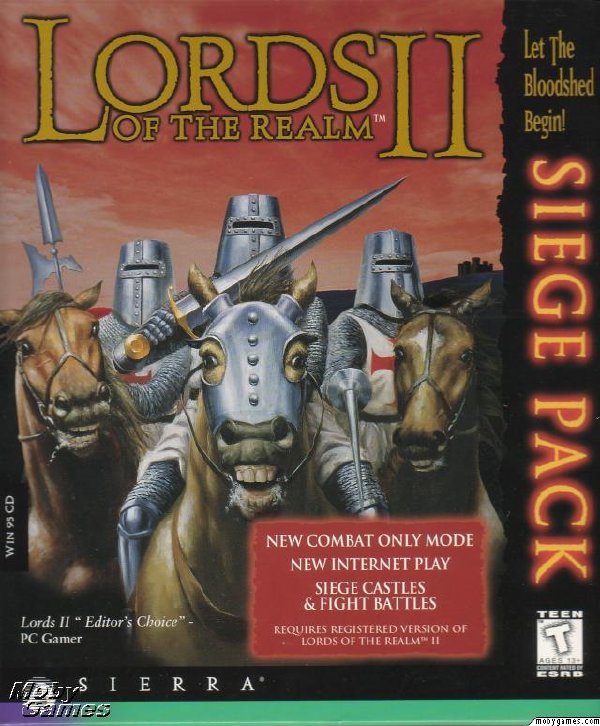
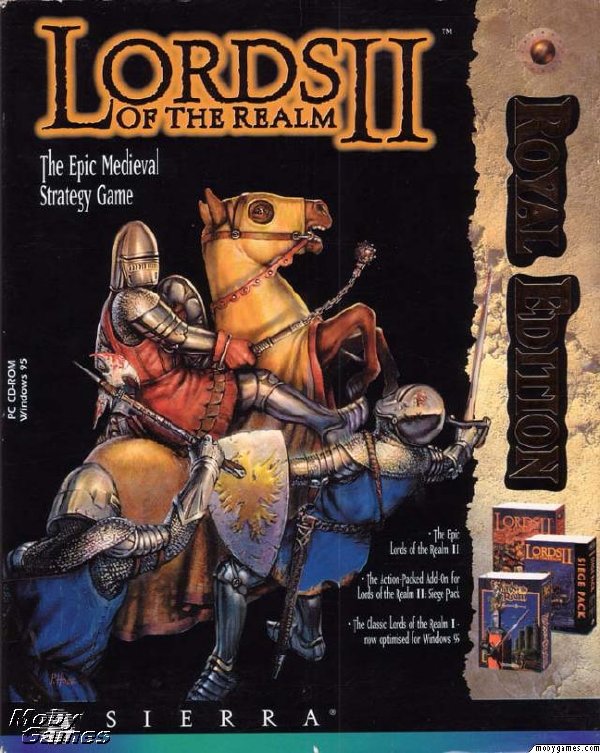
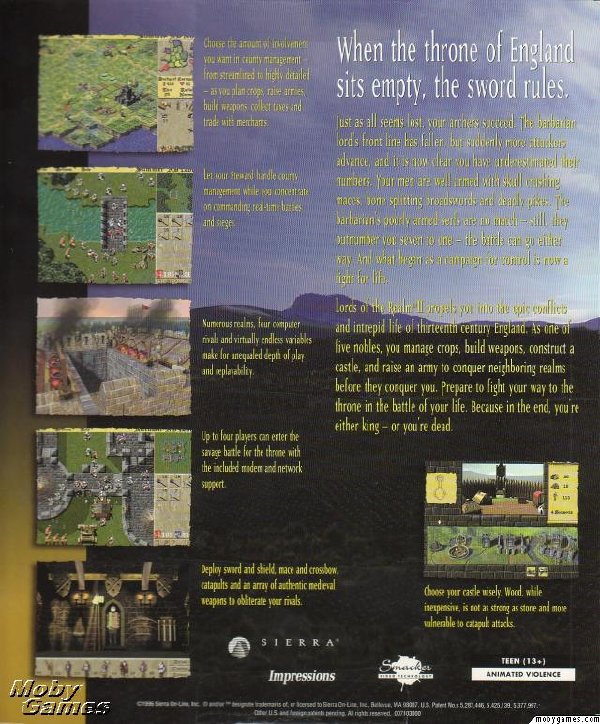
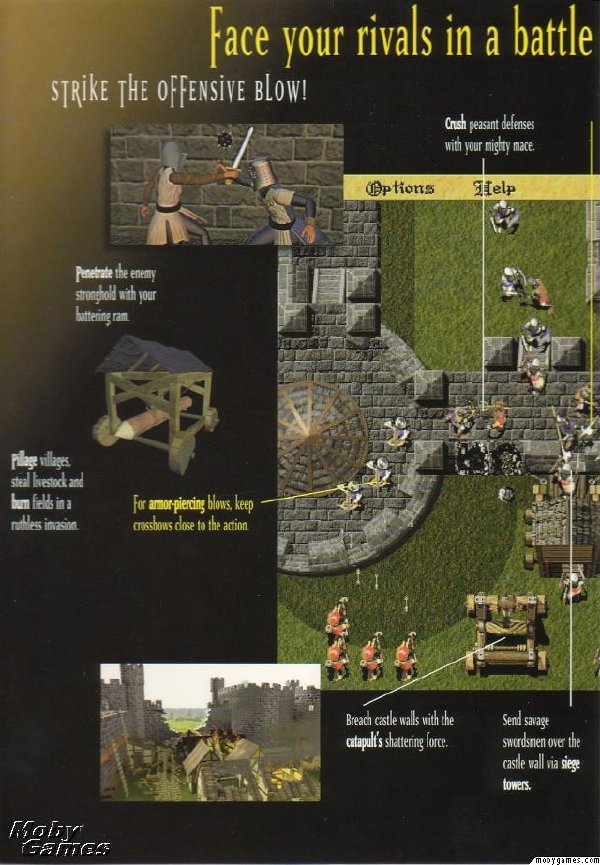
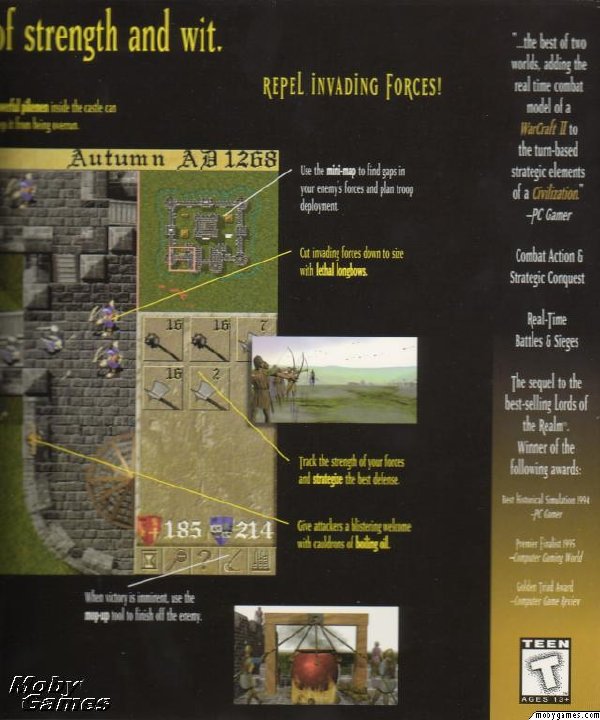
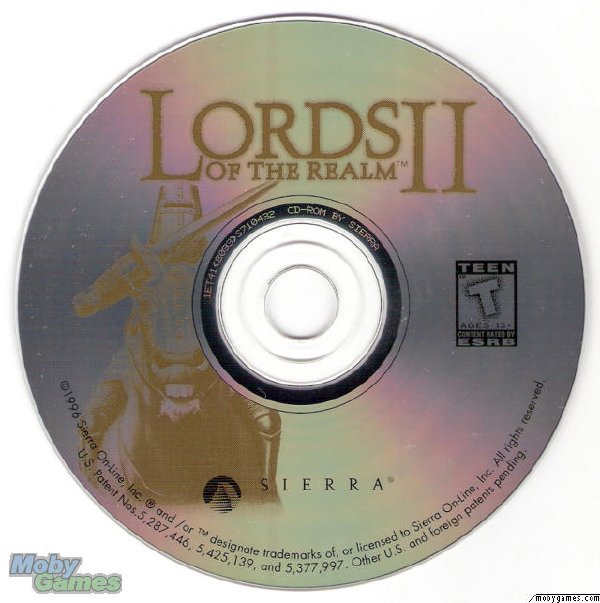
游戲畫面截圖
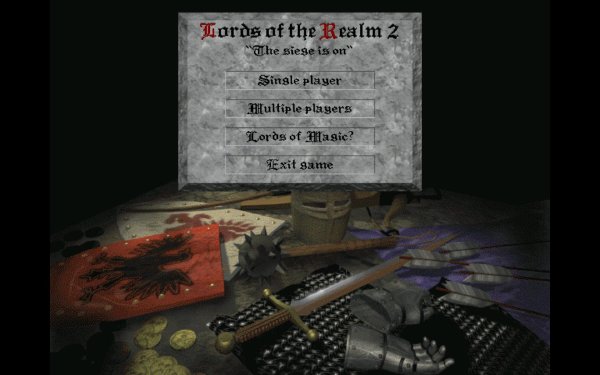
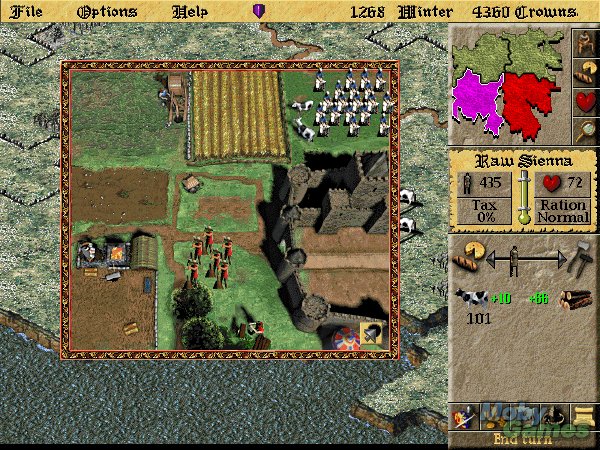
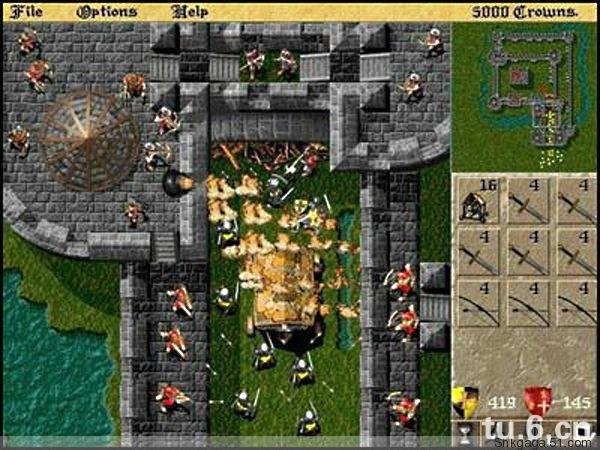
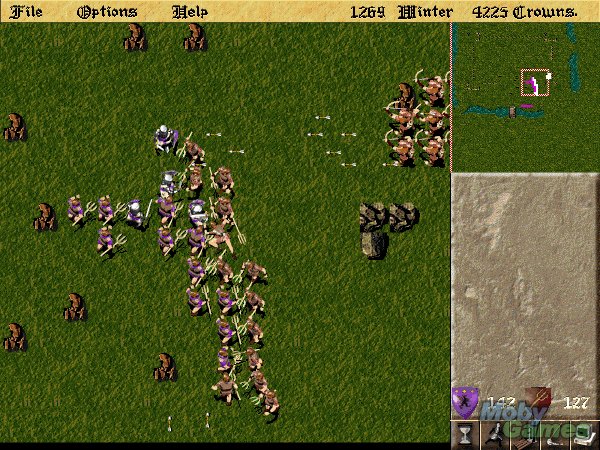
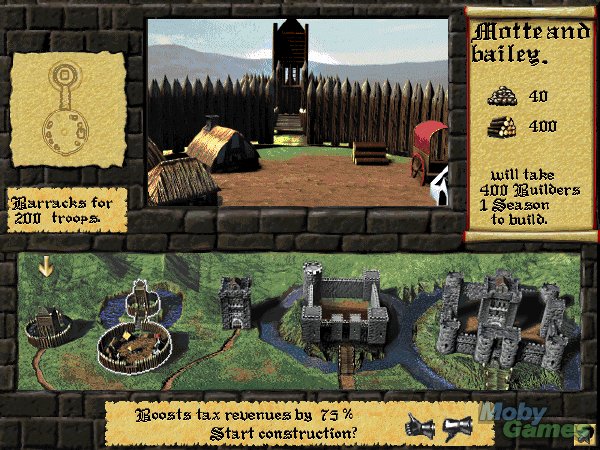
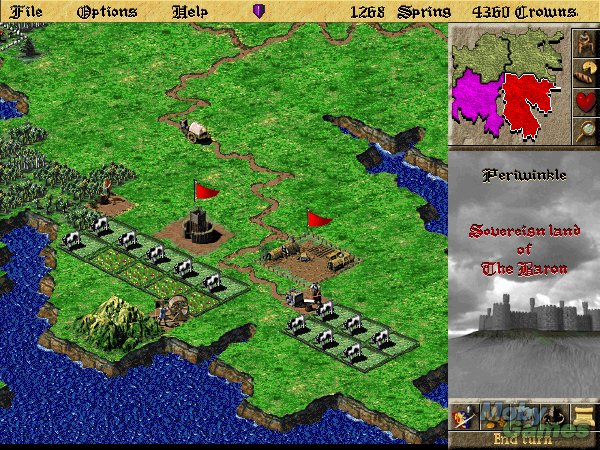
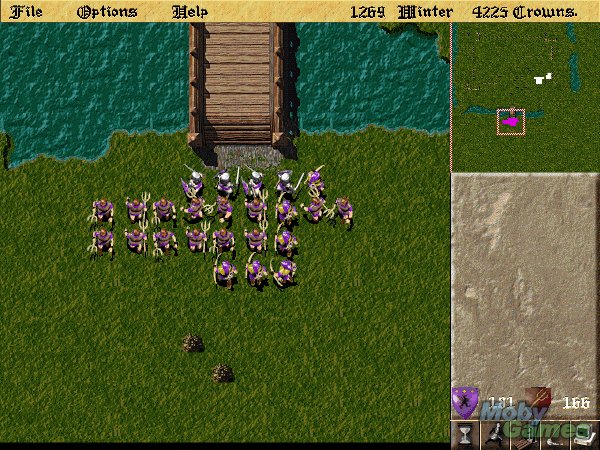
英文名稱: LORDS OF THE REALM 2
游戲類型: SLG 策略游戲
資源格式: 光盤鏡像
版本: 原版+資料片附XP,Vista兼容修正補丁
發行時間: 1996年10月31日
制作發行: Developer Impressions Games
Publisher Sierra Entertainment
地區: 美國
語言: 英文
簡介:

1代和2代網上已經絕版,3代電驢上有。
1代和2代算是策略經營游戲,到了3代基本就是RTS了
這裡發布二代值得重玩的經典。
英倫霸主, 原本惡名昭彰的Impressions公司, 憑這個1994年的作品來個鯉魚翻身, 得到玩家的應同讚賞. 整個游戲跟光榮的策略游戲頗相近, 玩者先要選擇一個貴族, 在自身的領地上努力經營(這包括牧羊放牛採礦筏木築城鑄劍徵兵...比三國志還要復雜), 富國強兵一番後便可到處征伐, 統一帝國. 對於喜愛在光榮游戲中當農夫的玩者來說, 因為英倫霸主在經營上很有深度, 所以玩起來或許會比三國志有更多的樂趣.
這裡是最經典的2代,游戲類似文明+全戰的融合。
說它是一套集大成之作,一點都不為過:它有《三國志》開疆辟地的成就感,有《危城爭霸》 攻城掠地的挑戰性,有《模擬城市》的經營哲理,又擁有《魔獸爭霸》的策略應用。
相信不少人都在找這個~~絕版送給懷舊的你
注意:游戲安裝方式2種
1.安裝方式:可以用加載鏡像的方式安裝游戲,但是不推薦(要手動輸入路徑)
2.加載鏡像即可游戲:直接用鏈接提供的[LOTR2安裝工具Lotr2]LOTR2.Run.in.XP.Vista.Patch.NoCD
這個是老外專門為這個游戲修改的20M的游戲安裝程序,兼容XP和Vista!!老玩家有福了!!
解壓後安裝,最後選擇你已經加載游戲鏡像的盤,開始菜單中就能進入游戲。
資料片不需要原盤!!增強電腦AI還有許多地圖
一、游戲簡介
這是一款由Sierra公司推出的新型態即時戰略游戲。游戲平台為Win 95。這是一個以中世紀 為背景的策略游戲。公元1268年的英國正處於群雄割劇的動亂中。此起彼落的戰火,把金黃 色的麥田染成一片血紅,將寧靜安詳的牧場燒成一片荒地。饑民們仰望著蒼天,期盼一位英 雄來結束這個充滿戰亂時代,統一這塊土地,一場中世紀歐洲大戰由游戲很好地重現。這款 游戲巧妙地將各類曾以在市場上大受歡迎的戰略、策略、經營及模擬類游戲融合在一起,說它是一套集大成之作,一點都不為過:它有《三國志》開疆辟地的成就感,有《危城爭霸》 攻城掠地的挑戰性,有《模擬城市》的經營哲理,又擁有《魔獸爭霸》的策略應用。游戲開 始也是先進行治理和建設,然後組建軍隊,攻城掠地,天下一統,但該游戲在許多方面又有 較新鮮的變化,確有其獨到和創新的地方,不會讓人覺得是在抄襲,反而有相得益彰之感。 戰斗畫面在486上就有SVGA的表現。人物動作流暢、生動,精致地刻劃出冷兵器戰爭的場面 。人工智能比同類游戲有了長足的進步,敵人也會行軍布陣,避實擊虛。
游戲是回合與即時模式並用:當治理國家大事與處理外交事務時采取回合制,可讓人謹慎地 處理各項事務,不至於手忙腳亂;進入戰斗後,在兩軍短兵交鋒時采用即時模式,不失游戲 緊張刺激的氣氛,惟在即時戰略模式時,敵人的人工智能似乎不是很強,我方部隊裡,只要 有足夠的弓箭手做後盾,再配合地形地物的利用,即便敵方部隊人數優於我方,要取得勝利 亦非難事。但由於游戲另有連線功能,若與朋友進行對戰時,其可玩性可就大大提升了。
游戲畫面采用高解析模式顯示,美工的表現極為不錯,游戲地圖並不是只限在古英倫帝國或 歐洲,而是連非洲或中國都可選擇。游戲要求的配備不是很高,在486機上進行游戲,也能 有讓人滿意的流暢度。
雖然這款游戲結合了各游戲的優點,但在操作界面上卻不若想像中的困難,即便是新手,應 該也可以很快地玩得得心應手。
就整體而言,這還是一個相當值得玩的游戲,尤其是簡化後的游戲進行方式,不需要費太多 腦筋在各種繁復的數字上,明快的游戲節奏,給人一種耳目一新的感受。
二、完全攻略
操作
進入游戲後可選擇Sigle player,然後進行新游戲(New),再輸入名字,選擇一個陣營就可 以來到美麗的英倫大陸。
屏幕左邊的大塊地圖就是游戲主畫面,在這裡可看到村莊、田地、城堡、部隊、牧場、礦場 、樹林和鐵匠鋪。在上面點擊鼠標右鍵會出現簡單的信息,只要點一下信息框右下角的箭頭 按鈕就可以關閉這條信息。
在主畫面上鼠標左鍵是重要的操作鍵。當點擊村莊時,將出現農民工作情況的詳圖,全圖分 9塊,左上是采石場或鐵礦場,依實際情況而定;左中部是開發荒地;左下是鐵匠鋪;中上 是種地;正中是無事可做的人,如果在此雙擊時以把人力最大限度地分派到農業生產中去;中下是伐木,如果在領地上沒有樹林,這裡就不會有工作的人;右上部分是放牧;右邊的和 間部分和右下部分是建造城堡。你可以用鼠標框起一些人,放到工作需要的地方,以此來改 變發展的重心。同時不要讓人閒著,也不要缺少人手的地方(閒人是灰色的坐著的人,而缺 人的地方會有一個直立的黑色人影)。
用左鍵點擊某個工作場面時,就會出現鐵匠鋪的內部細圖,牆壁上掛的是可制造的武器,選 擇一個(點擊一下),它就會放在桌上,表示當前正在制造該武器。在下方還會有一些信息, 諸如有幾個鐵匠,每季度耗費多少木材,多少鐵,能造出多少武器等。
當點擊田地時,會出現土地利用的詳圖。下方有三個按鈕,第一個按鈕表示將此塊地閒置不 用;第二個按鈕表示種糧食;第三個按鈕表示放牛。可根據實際情況來調整每一塊土地的用 途。
在點擊鐵匠鋪、伐木場、鐵礦場和采石場時,可讓他們暫停或開始工作。
當點擊部隊時就會出現一條線,將鼠標移到目的地按一下就表示部隊開拔。如果目的地是敵 人的部隊,就會開展一場野戰。如果是敵人的城堡,就會發生一場攻城戰,並會出現攻城器 械的制造窗口,可以制造發石車、雲梯和攻城車。按上下箭頭可增減器械的制造數目,決定 後按“進行”(Proceed)按鈕。經過一段時間的制造、完工後就可開戰。
用鼠標右鍵點擊部隊時,會出現部隊的控制窗口,或者當你在城堡資訊窗口中按中間的向右 箭頭也能進入駐防部隊的控制窗。窗口的上半部顯示該部隊的詳細資料,下面有三個大按鈕 ,第一個按鈕可以理解為移動,而對城堡裡的部隊來說就是出城;第二個按鈕是解散,如果 組建該部隊的母城還在,那麼所有人將回到本省去,否則將並入當前所在的省,而武器將全 部入庫;第三個按鈕是拆分,可以在本回合部隊未走動的情況下將它分成兩支,只需在隨後 的控制板上按向左或向右的箭頭來調整兩支部隊的人數即可。如果將城堡裡的部隊分成兩支 ,那麼右側的分隊將出城,此時要注意每一支部隊的人數都必須超過50人。唯一的例外是在 一支部隊移入城堡,而城堡又容納不了這麼多人時,也會出現拆分窗口。此時右側的分隊將 入城且可以少於50人。
當點擊白色大篷車時會進入交易畫面,可以點擊某個貨物來買賣,當數量為零時,按向上的 箭頭表示買,按向下的箭頭表示賣,若數量不為零,那麼上下箭頭就用來調節數量。
屏幕上方的菜單有以下幾個項目:第一個是文件(File)菜單,用於存儲等系統功能。第二個 是“選項”(Options)菜單,它的子菜單的第一項是“超級”(Advanced),點開後出現3個開 關,第一個是“超級種地”(Advanced Farming),如果為ON,那麼耕作人數的變化將由系統 自動調整。第二個是“軍糧”(Army Foraging),如果為ON,那麼部隊將吃當前所在省的糧 食,而不再是他們母省的糧食。第三個是“探索模式”(Exploration),如果為ON,那麼所 有不屬於你的省都將是黑色的,將由部隊去逐步探清。子菜單第二項是“聲音”(Sound), 可以調整音樂、音效和語音。子菜單第三項是“顯示”(Display),用於調整動畫的顯示與否。最後兩項是“游戲速度”(Game Speed)和“卷軸速度”(Scroll Speed)。最後有一個“ 幫助”(Help)菜單,第一項是“游戲幫助”(Game Help),用來確定幫助屏和工具幫助項是 否要打開,而下面是一些“如何進行……”(How to……),是如何完成某項操作的解釋。
屏幕的右方是一些功能按鈕。最上面是一幅地理簡圖,在此你可以看到每個領主的版圖大小 ,當用鼠標點擊某個省份時,就可以快速切換到該處去。簡圖旁邊是一豎排四個狀態鈕,當 點擊其中某一個時,版圖就會切換成狀態圖,每個省份的不同顏色表示不同的狀態。第一個 是工作狀態鈕,如果某個省份顯示紅色,就表示工作缺乏人手,紫色就表示有閒人存在;第 二個是食物狀況,紅色表示缺少而紫色表示充足;第三個是快樂度,紫色表示快樂度高,紅 色表示不快樂。最後一個是“全景”(Over View),用來縮小顯示主畫面。
在功能按鈕下面有兩個信息鈕,分別是人口和快樂度,可提供人口與快樂度的增減情況。信 息鈕下面是稅收和食物的調節鈕。再下面是工作比例的滑動條,用來調節農業和工業所占的 比例,工農業的情況將在滑動條下方顯示。左邊一列依次是牛群放牧、糧食種植和荒地開發 。右邊一列依次是原料采集(包括木材、石料和生鐵中的一到兩種)、武器制造和城堡建設。 點擊圖標將會得到詳細資料,圖標外有紅框表示人手不夠,此時需將滑動條上的人形圖標向 這一側移動。反之,圖標外有藍框表示人員過剩,此時就需將滑動條上的人形圖標向另一側移。
狀況板的下面有5個命令鈕,第一個是組建軍隊。彈出的窗口中間會顯示你的武器數量,你 可以根據這一點在上方點擊人數滑動條來決定將多少農民劃撥到軍隊中,確定後按“繼續” (Continue)箭頭,然後點擊牆上的武器並選擇數量來武裝他們,最後按右下角的“生成”(C reate)鈕即可。如中途對武裝情況或人數不滿意,可按“變更”(Change)鈕重來,或按“取 消”(Cancel)鈕取消。有時會在這裡遇到雇傭軍,假如有雇他們的錢話,就會多出一個“是 ”(Yes)和“否”(No)的按鈕,用來決定是否雇傭。不過要注意,雇傭軍和部隊都是需要每 個季度花錢來維持的,一旦連續兩個季度發不出工資,就會發生逃跑事件直至兵變。第二個 按鈕是檢查國庫,可以看到錢、木、石、鐵和武器的庫存情況。第三個按鈕是運輸,用於控 制從當前省運牛和糧食到另一省,操作時選好目的地和數量,然後按“是”(Yes)按鈕即可 ,不過物品要在路上走一段時間才能運到。第四個按鈕用於建造城堡,選好一種城堡類型後 ,右上角會有所需原材料的顯示,如果材料不夠,就不會開始建設,必須等材料齊備後人手才會調撥過去。最後一個按鈕用於外交,可選一個敵方霸主,然後選擇獻禮、同盟或是威脅 等行動。外交在這裡並不太好用,因為敵人經常背信棄義,並且勝負也不靠外交手段來獲得 。
屏幕右下角是個“結束當前回合”(End Turn)的按鈕,用來結束當前回合。雖然本游戲在部 隊移動和戰爭時都是即時制的,但在建設中還是采用回合制,所以需要這個按鈕。
增加人口
要想征服天下,首先必須國富民強,而其中人民更是關鍵,參軍打仗需要人,治理建設更需 要人,所以要想最終取勝就必須有足夠多的人口。人口只能靠自然繁衍來增加,因此吃飯就 成了關鍵。這也就是游戲的第一個目的:養活足夠的人口,使他們快樂,並使他們參加各種 生產。
當人民有了充足的食物,他們就會慢慢繁衍,人數越來越多。人口的出生率取決於快樂度, 而死亡率取決於健康狀況。快樂度可以通過降低稅收和增加食物來提高,還可以通過購買淡 啤酒(Ale)來提高(至少每10人1桶),而健康狀況可以通過增加食物來得到改善。只要保證你 的人民健康快樂,很快就有足夠的人來組建軍隊了。
養牛
游戲開始時的頭等大事是生產盡可能多的食物,主要途徑有兩條:養牛和種地。許多玩家會 先選擇養牛,因為一開始會有大約100頭牛,只要好好地放養它們,人民就能快樂地喝著牛 奶,吃著牛排而成長起來。放牧要有足夠的牧民和足夠的牧場。如果牧民不夠,牛群會因照 料不善而不斷死亡,此時需要點擊村莊,打開人員控制板,從其他地方選幾人放在此處填補 人員空缺。另一方面,如果牧場不夠,牛群就會因擁擠和牧草不足而死亡。如果每塊牧場裡 都有三頭大牛,且奶牛的成長比例不如以前高了,就表示牧場不夠了,此時就需要點擊一塊 閒置不用的好地,將它開發為牧場,牛群馬上就會被疏散開。一般說來,一塊地大約養25至 30頭牛為宜。好地用完後,可點擊一塊灰黑色的荒地,在右下角按左邊的開發圖標,就能在 幾個季度後將它整治成良田。如果要加快開發速度,可點擊村莊,多調些人手來干活。開發 通常需要4個季度,因此同時開發幾塊地,可讓多余的人手到其他地塊上工作。
由於養牛非常不方便,當牛群擁擠而土地開發尚需等待數季之後時,只能坐視牛群不斷死去 。而且每個季度都要操心這些牛,或調集人手,或增加牧場,同時還得兼顧其他事物,一旦 照顧不周就會帶來不良後果。所以,只要有條件還是要種些地。
種地
要種地就要有種子,當大篷車來到領地時,點擊它,將交易窗口打開,買一些糧食作種子, 每塊地不超過十包。而後點擊一塊好地,按一下耕作圖標,再分派一定量的人手,就算是將 種子種下地了。農民們在每年冬季會往每塊地上播5到10包種子,等到第二年秋天每包種子 就會有12包左右的收成。而且只要種子和人手足夠,他們就會一直循環往復地耕種,無需替他們操心。當然,如果人手不足,收成就會不好,這時可從圖標的外框是紅是藍看出。種糧 食最大的好處在於可以囤積,不過偶爾會鬧一次鼠災,吃掉一些糧食。但是用這點損失來換 取每季更多的時間來處理其他事物,還是很合算的。
軍隊的組建
要組建強大的軍隊,要有足夠的武器。電腦對手經常會派出大批農民出戰,但自己可不要這 麼做。
武器可以購買,也可由鐵匠鋪來鑄造。部隊種類最好能齊全一些,既要有射程極遠的弓箭手 ,也要有威力較大的弩手。既要有能作快速反應的爵士騎兵,也要有防御力良好的劍士。在 經濟不寬裕的情況下,有一些便宜的狼牙棒手和矛兵也湊合了。
有了足夠的武器後就可以創建軍隊了,一次不要組建太多的軍隊,否則會使人民的快樂度大 幅度下降,從而影響人口的增長。每次可組織一兩百人,然後將他們合並到一起,通過這個 方法逐步組建出一支大軍團,不過人數不能超過1500。
城堡的防守
有了部隊以後千萬不要把他們放在野外,應該建造一個較大的城堡讓他們防守,依托著堅固 的石頭城堡將使你的部隊以一當下。如果有護城河的話,利用弓箭手可達到很好的防御效果 。只要在城頭擺上幾十個弓箭手,就足可以射退四五百精銳敵兵,再用火罐來輔助防守,敵 人的進攻大多無功而返。如果你不想親自指揮也可以讓電腦自動計算勝負,你會發現守方的 損失簡直是微乎其微。
不過由於城堡內空間有限,只能駐扎一定數量的人,並且當城堡受攻擊時就不能再將其他部 隊派駐進去,所以一定要經常注意駐防部隊的損耗情況。最好是把以後再組建的部隊藏在城 堡後面,這樣敵人來攻打時,就會在城下損兵折將,而你的部隊則養精蓄銳,等待決戰的開 始,並且可以經常利用分兵進城的方法保持一支滿員的守城部隊。
攻打城堡
游戲中可以建造的城堡從小到大共有五種,對於前三種沒有護城河的城堡,我們可以造一部 攻城車,讓它上前將門撞開。兩扇門都開了以後,敵人會龜縮到軍旗處,這時派一個騎兵去 攻擊那些火罐,引誘它們噴火。最後將我方的近戰部隊全部派上,將敵人尤其是敵人的弓箭 手團團圍住,讓他們施展不開手腳,而我方的弓箭手躲在後面射箭。這樣一仗下來,如果我 方兵種搭配合理的話,一般我方的損失不會超過敵人的一半。
對於後兩種有護城河的城堡,就需要有較多的人馬,尤其是劍士,還需要造三輛發石車。首 先用發石車在城牆上砸開一個缺口(選擇發石車後將鼠標移至城牆上,若光標變暗則表示可 以攻擊),再派二、三十名劍士去填護城河(讓他們走到河邊即可),最後一擁而入。如前法 炮制,我方的損失也不會比敵人多。另外對於最大的城堡,它的內部還有一道門,可用人去 砸開它,也可以讓弓箭手登上外圍的城頭與敵人對射。
由於游戲中同一領主的所有省份都必須連成一片,不允許有海外”飛地”,故掠地時要選擇 邊界接壤的省份進行。
野戰
戰斗不僅是攻打城堡,也會發生野戰。當你去進攻一個不屬於任何領主的省份或是未建造城 堡的省份時,就會與村莊中的農民發生野戰。或是部隊在路上行軍時,會遭遇到敵人的攔截 而發生野戰。野戰是非常慘烈的,必須親自指揮才能避免過大的傷亡。野戰取勝的關鍵是地 形的利用、如果有樹林的話,戰斗會容易一些。通常我方應該選擇一個口袋狀的地方,將弓 箭手放置在底部,外面用劍士護衛,以靜制動。同時讓騎兵和狼牙棒手圍攻敵人的弓箭手。 這樣的戰術在敵人主動進攻的時候會相當有用。
有時敵人不主動發動進攻,而是以逸待勞,等待我方的沖鋒,這時要小心地靠近敵人,同時別忘了保持隊形,躲到離敵人最近的一片樹叢背後(因為弓箭較難射透樹林)布好陣形,派一 個騎兵冒著箭雨去引誘敵人的部分人馬過來,造成局部的以多打少的局面,達到逐步蠶食的 目的,最終消滅所有敵人。如果沒有樹林。那麼橋頭、石欄也能達到同樣的目的,甚至在敵 人弓箭手射程之外的空地上也可以用這個戰術。
戰斗中的操作
與其他即時戰斗游戲相似,用鼠標拉框選人、點擊選人、點擊目的地來移動或攻擊等,都是 大家所熟悉的。游戲特有的熱鍵有,在拉框選了一些人後,按H鍵可以讓他們水平排成直線 ,按V鍵可以讓他們垂直排成線,這在布陣時比較有用。當部隊被選擇後,可以用 Ctrl+數 字鍵的方法來編號。另外,戰斗剛開始時。部隊會被自動編號,可按數字鍵看看是否滿意。 地圖下面是一個部隊選擇扳,當前所選擇的部隊會在此以按鈕的形式顯現,可以點按鈕來取 消某個部隊的選擇。
再下面是5個功能鈕,第一個按鈕是暫停與啟動鈕,戰斗開始時是處於暫停狀態的,可以觀 察一下地形,決定你的戰術,然後按一下來啟動戰斗。而在戰斗的中途也可以用這個鈕暫停 ,做一些改動。第二個按鈕是撤退,要注意的是撤退會造成己方一定量的傷亡,並且少於50 人的部隊會被徹底消滅。第三個按鈕是放下吊橋,只在打防守仗時有用,並且放下後就不能 再拉起,等於放棄了一道保險,故不要輕易使用它;第四個按鈕是沖鋒。第五個按鈕是自動 計算,即由計算機通過雙方的實力對比來確定勝負和傷亡。這個辦法在攻城戰時對防守方有 利,野戰時對“價格貴”的部隊(如騎兵、彎手和劍土)有利,可選擇使用,以加快一統天下 的步伐。
尋找多年的游戲《英倫霸主2》。。問題解決,分享一下
http://game.ali213.net/thread-2661022-1-1.html
游戲畫面比較古老,但可玩性毋庸置疑,對畫面無要求的朋友,建議體驗一下,雖然是英文的,但是比較好理解,感謝情比金堅 提供解決光盤模擬問題。
重發 絕版LORDS OF THE REALM2
http://game.ali213.net/thread-2511338-1-1.html
此游戲以前發過以前 後來連接壞了貼子也找不到了 這次重發 又是辛苦的找了N天下載了N天 終於拖完拉
游戲類似全面戰爭 有一個策略界面和一個戰斗界面 但是簡陋非常多 畢竟是95年[還是97?我忘了```]
英倫霸主2的資料包 此資料片由 情比金堅 上傳
感謝情比金堅兄弟 是他辛苦的拖下了這個資料包~~
有野戰攻城戰 找了很久找不到的兄弟 快下吧
必須物理光驅及xp下運行問題搞定了
誰知道Lords of the Realm II(中世紀領主2) 在xp下怎樣進入?
對於新發行的中世紀領主3我感到很失望,相反對於96年發行的2情有獨鐘,可當我想有重溫它時,卻發現不能安裝,大概安裝到17%就出現錯誤。於是我想在原cd上直接運行游戲,游戲是進去了,但要選擇單人游戲時它提示插入游戲盤,真是郁悶啊,有誰知道怎樣進入的話告訴一聲,萬分感謝!
到這個鏈接去下載xp/vista運行補丁 (本貼提供)
http://www.demonoid.com/files/details/1717251/775222
然後通過這個補丁進行游戲安裝。用deamon tool加載資料片盤[原版也可]就可以玩了。安裝時提示光驅選擇 請選擇自己的虛擬光驅盤號 [非物理光驅]
很經典的游戲,找尋多年一直未果,電驢上雖然還有他的蹤跡,但是已經沒有速度了
我掛電驢下載已經有大半年了,一上網就掛著。可是到今天也只完成。
游戲畫面比較古老,但可玩性毋庸置疑,對畫面無要求的朋友,建議體驗一下,雖然是英文的,但是比較好理解,感謝情比金堅 提供解決光盤模擬問題。
http://www.squirtthecat.com/games/lords_of...dex.html (本貼提供)
補丁安裝包:lords_of_the_realm_2_install_20080706test5.msi (本貼提供)
使用方法:直接用lords_of_the_realm_2_install_20080706test5.msi 安裝包安裝,快結束以前,它會問你游戲光盤會放在哪個光驅,記得設定在daemon模擬的那個光驅。光盤下載好以後,如果要打原版游戲就用daemon載入lords_of_the_realm_2光盤,如果要打資料片就裝入expansion pack。
記得不要用光盤安裝游戲,直接用lords_of_the_realm_2_install_20080706test5.msi 安裝包安裝,快結束以前,它會問你游戲光盤會放在哪個光驅,記得設定在daemon模擬的那個光驅。光盤下載好以後,如果要打原版游戲就用daemon載入lords_of_the_realm_2光盤,如果要打資料片就裝入expansion pack。
Lords of the Realm 2 + Siege Pack
Developer Impressions Games
Publisher Sierra Entertainment
Released 1996
Genre Turn-based strategy
Mode(s) Single player Multiplayer
Ratings ESRB: Teen (T)
Platform(s) PC, Macintosh, Amiga
Media CD-ROM
System requirements 66 Mhz processor, 8 MB RAM, 34 MB Hard-disk space, Windows 95
One of the most underrated strategy games of all time, Impressions’ Lords of the Realm II is in my opinion the best game designed by David Lester, prolific designer and founder of Impressions. This mediaval empire game improves on the already superb Lords of the Realm in numerous aspects, adding both complexity and replayability.
Your objective in LOTRII remains the same as it was in the first game: The king in mediaval England is dead, and it’s up to you to fight the other nobles for the throne and succeed him. Again like the first game, you are put in charge of both the strategic level (i.e. making decisions for your entire kingdom), and tactical (i.e. taking control of troops in combat) - although you can have the computer handle the combat for you. At the strategic level, you view the action from the attractive isometric map, where you can move armies, adjust economic parameters, manage your resources, and engage in diplomacy with other noble houses. As in the first game, your success in the game hinges on proper resource allocation and maximizing farm output. Each county in your empire has a fixed amount of arable land, which you can use for farming wheat or raising cattle to feed your peasants. Sufficiency in, or surplus of, food supply helps increase population, which in turn will increase taxes and the size of your army (recruited from peasants). Some peasants must also be assigned to gather other useful resources, build castles, and produce weapons of war. You can also hire mercenaries at the mercenary guild, but they are costly and not always co-operative.
When armies clash, the game switches to a tactical real-time battle mode, which looks similar to Mindcraft’s Siege series, and is quite fun to play. Armies consist of peasants, archers, macemen, swordsman, crossbow troops, pikemen, and knights. Each type of troop has its own strengths and weaknesses, although an army of knights usually is practically invincible. What should prove more interesting to an armchair commander than simplistic open-field battles are the sieges, because you must decide how many siege engines, catapults, and battering rams to use, and where to position them. The computer players are reasonably challenging - they are very easy to beat in the first turns of the game, but become worthy opponents in the later stages. Advanced options such as a hidden map, advanced farming and army foraging, and others make the game more complex, and help increase the replay value.
In addition to the standard campaign play, LOTRII includes a nice custom scenario builder and a few multiplayer modes including DirectPlay support. On the downside, there is no variety in terms of victory conditions -you simply must conquer every county to win. This rigid condition, coupled with the level of micromanagement required for each county in the later stages, makes the game tiresome toward the end (especially when you are clearly going to win, but must first tolerate the tedious process of crushing the last counties of the last enemy). Also, more castle types would have been nice (although you get those in the Siege Pack add-on).
All in all, LOTRII will please fans of the first game, as well as anyone who likes turn-based/real-time gameplay based in the medieval period. The game is not very original, but it is still a lot of fun and surprisingly replayable. Highly recommended to anyone who likes strategy games.
Siege Pack adds much more to the game than new maps. Among the additions are: a more challenging AI, a custom series of games, 20 new maps, a map editor, faster Internet support, Skirmish Mode, sieges with 10 new castle designs, as well as enhanced diplomacy and more random events.
Lords of the Realm II is a computer game published by Sierra Entertainment and developed by Impressions Games. It was first released for the PC on October 31, 1996, and is the second game in the Lords of the Realm series.
The game takes place in a medieval setting, with rulers of several counties warring for the right to be king of the land. Players grow crops, accumulate resources, manufacture weapons, manage armies, build and lay siege to castles, and attempt to conquer their enemies.
Contents [hide]
1 Overview
2 Gameplay
2.1 Diplomacy
2.1.1 Computer players
2.2 Town administration
2.3 Counties and maps
2.4 Resource management
2.4.1 Food
2.4.2 Population
2.4.3 Taxes
2.4.4 Industry
2.4.5 Resource Availability
2.5 Castle building and management
2.5.1 Castle Defenses
2.5.2 Raising an army
2.5.3 Military
2.6 Movement and battle
2.6.1 Custom battle
3 Sequels
4 In popular culture
5 References
6 External links
[edit] Overview
Lords of the Realm II is very different from many medieval strategy games. The game has a strong medieval feel, but it is historically based. There is no magic, and unlike many strategy games, it has no technology tree. Perhaps its most remarkable feature is the need to carefully manage food, population and happiness levels in order to build population levels whilst avoiding Malthusian meltdowns. The large number of both random and player-generated events that can affect province happiness provides an almost constant level of challenge for the player, which is part of the reason the game is regarded as a classic by many players.
There are two major game types that the developers merged into a successful hybrid. The first is turn-based resource management. Players grow crops, accumulate resources, manufacture weapons, manage armies, build and lay siege to castles, and attempt to conquer their enemies. The battles are real time, with players able to control units individually or in group formations. Players may also allow the computer to calculate the outcome of the battle.
Compared to the original, Lords of the Realm II is much more robust, with better graphics and music, and an improved management system.
[edit] Gameplay
The game begins with the player ruling over a peaceful and unproductive county with a small population.
[edit] Diplomacy
Diplomacy can influence the course of events in the game, although there is little opportunity for its use among the mostly-violent interactions between counties. The player can engage in trade and communication by sending insults, compliments, money, or an offer of alliance to other nobles. Insults and miserliness will turn the noble against the player, but monetary generosity and compliments will have the opposite effect.
Closely related to the Nobles, diplomacy consists of the players' relationship with other nobles. The player send compliments, insults, bribes, or propose an alliance. Depending on the relationship with each noble, the player has a certain amount of leeway when attacking nobles. Ultimately, if the player attacks a noble enough times they will be irrevocably at war. If a player is allied with a noble, and attack that noble during a time of alliance, the player's relationships with all nobles are hurt, and the formerly allied noble is now at war with the player. The nobles will not attack you if allied, with the exception of the Countess. If the player is allied, the player may request assistance from attacking troupes, or ask to attack a specified county.
[edit] Computer players
The game has limited diplomacy, where the player can make alliances and send money for bribery and to induce nobles to attack other nobles. The computer opponents are different characters with distinct personalities and strategies. There are four computer Nobles available. The game also includes LAN play with real players. The four computer nobles are:
The Baron - A wise and cautious man, the Baron seeks to consolidate a strong base of operations before further expanding his territory.
The Bishop - A clergyman who thinks he is divinely appointed to rule, he relies on large armies comprised mostly of peasants and archers for attack. His people are seldom happy due to his continual creation of large armies. He generally constructs large expensive castles for his counties.
The Countess - A cold, calculating opponent, the Countess's main focus is expansion, and as a result she tends to overextend herself. If made an ally, she cannot be trusted to coexist peacefully with you, and will attack even though you are allies.
The Knight - Young, brash, and aggressive. The Knight will aggressively attack counties. While he generally constructs small weak castles for his counties, he usually fields large armies which are difficult to defend against early on unless the player is resourceful.
[edit] Town administration
There are seven areas to which the peasants can be assigned: cattle herding, farming, wood chopping, blacksmithing, castle building, tilling, or mining. Citizens not active in one of these roles will remain idle.
Wood, iron, stone, and wheat are measured in tonnes; livestock and weapons are measured in individual units. These resources must be managed in order to build castles, placate hostile neighbors, and sustain the populace.
Towns are situated in counties; usually a county will have between eight and sixteen units of land to work. The exact makeup of the land varies. Towns always have a blacksmith workshop and may also have lumber, mining and quarrying but never both quarrying and mining in the same town.
[edit] Counties and maps
At the beginning, the player has only one county and a few hundred peasants. As the player conquers more counties, the first ones, now prosperous, can send armies and money to help the newly conquered ones. The game ends when the human player loses all counties, or conquers the entire enemy occupied map. A player must only conquer the nobles, not all neutral counties as well.
The game consists of a map with several different counties, comprising a single nation or geographic area. These counties have a main village, along with several types of industries available to utilize for conquering nobles and fields designated for food growth. Every map begins in the year 1268 in the winter season. There are four different turns per year, beginning with winter, spring, summer, and autumn.
There are a preset number of merchants per map. These merchants travel the land, and if they are in a player's county they may purchase material from them.
Each county is either a neutral county or a county under the rule of a noble. The territory of each noble is coloured to differentiate the board (for the Baron, it may be red; for the Knight, yellow, etc). Starting out, each noble has one county as their own, and all other counties are neutral.
To expand a noble's lands, the noble must capture the county by either conquering the county town seat, or if there is an existing castle that is currently manned, lay siege to that castle and breach its defenses to overtake it. No neutral counties have castles naturally. If a noble has been driven from the county by revolt or other means, and the noble erected a castle, that will remain, but the county peasants will never man it in a neutral county.
On the map, all of a noble's existing territory must be touching. If player has four counties in a straight chain where each touches only the other, and an opponent captures one of the middle counties, the noble will automatically lose the weakest counties that have been sundered from the main body of his/her empire.
[edit] Resource management
The proper mixture of resources is constantly changing to meet the demands of individual situations; stone will be needed to build castles at one moment, but then wood and iron may become more important.
[edit] Food
Food is the resource requiring most careful management. Each province has 8 to 16 fields, which can be used for growing grain, cattle, or left fallow. Soil can become enhanced or degraded by over- or underuse, and random seasonal events such as good weather, floods, droughts, rat plague and so on also play an important part.
Unlike Lords of the Realm, which has three main food types (grain, sheep, cows), this game features only cows and grain for food. The player can run three types of food economy: allocating all fields to grain, all fields to cows, or running both cattle and grain together.
Cows - The primary food source used by the PC nobles, cows require a lot of the existing population to maintain its status as a substantial food source. The two main supplies provided by cattle are meat and dairy.
Grain - A food supply that requires a much smaller amount of the population to maintain than cows for three of the four seasons per year. For winter, spring, and summer, grain requires little of the population to bear a bountiful harvest. Grain therefore allows a player to allocate most of the population to other industries. The autumn harvest is very labor-intensive, and demands a very large portion of the population to complete. Overall, however, the player gets much more industry-production out of a population by using a pure grain food economy.
Fields - Like industries, there are a preset number of fields per county in various states of usability. A field can either be barren or fertile. If a field is completely barren, it appears as a solid grey square. If peasants have been allocated to work on the field to make it fertile, it will have either one, two, or three fertile mini-squares filled into the overall square, indicating its progress to rehabilitating the field into a restored fertile status. Most counties starting out have some barren fields.
There are four ways a fertile field may be made barren, barring the advanced farming option (dealt with later). The first two ways are drought and flood. If a drought or flood occurs (prompted by the computer and determined within the game's code one turn previous), a field will be lost. For example, in the summer the game determines you will lose a field but does not tell you. The player selects End Turn, and in autumn the player will be notified of the lost field. To escape this fate, the player must go back not to the summer save file but the spring save file (if such a file does in fact exist). If a drought or flood occurs and it is a grain field, then a significant amount of the grain output for that year will be lost. The third way a field may be lost occurs when locusts strip the field bare and the fourth way to lose fields is if they are destroyed by enemy troops invading your lands.
[edit] Population
Each county has a population. This population is effected by many different factors: overall happiness, tax rates, health, and food supply. Players know exactly how many peasants they have, and how many births, deaths, immigrants, and emigrants they have each season. Overall population trends can also be traced via the population information screen for each county.
Emigration & immigration - Like any population, people will leave one county and go to another. If the county is properly managed, this will seldom happen where people will leave. People will leave counties when little or no food is available, happiness is low, the county is overtaken, or taxes are excessively high.
Food supply - If a county runs low on food, happiness will decrease, health will suffer, and if the situation goes to an extreme, roving bands of starving revolutionaries will go throughout the lands looking for food.
Happiness - The most powerful influence on the happiness of citizens is army recruitment. Town denizens will become angry when their young men are recruited into the army, and the presence of even the smallest army will decrease happiness. Citizens must be placated to balance the unhappiness that will result from army recruitment. Other influences on citizen happiness include food, health, and taxes. Hungry, sick, or over-taxed citizens are unhappy citizens. The player controls food through rations, which can be set from none to triple. Higher food rations yield happier citizens. Citizens happiness may also be increased through the purchase of ale or lowering of taxes.
Health - A fairly stable factor. If the food supply runs low and people begin to starve, the health will naturally deteriorate and emigration will begin. Occasionally, the game will randomly assign a county the Black Plague, which will kill off a large portion of the population and weaken the total population for several seasons. Depending on how the noble responds to the plague, a county can be feeling its effects for a few years.
[edit] Taxes
Each country has its own tax rate as determined by the noble or general population if it is a neutral country to generate income to fund the noble's campaign for the crown. The higher the tax rate, the more happiness is deducted from the population of that specific country. Overall, if a player has a county that has normal health with a normal food supply, the tax rate can be set to 7%, which penalizes the county two happiness points, and barring other events the happiness can be maintained at 100%. If you reach a tax rate of 19% and above, then not only is that county's happiness penalized, but all your counties are penalized, though not nearly as heavy as the overtaxed county. There is a glitch that causes this tax penalty to operate incorrectly. If you have a large number of counties and you put the tax rate up to 50 percent on all of them, the integer that is supposed to subtract points from your population actually becomes positive, meaning your people will be happy despite astronomical tax rates. Money earned from high tax rates can pay for armies and buy resources from traveling merchants.
[edit] Industry
In many ways, industry is the heart and soul of any winning strategy in Lords of the Realm II. With the four major industries (blacksmith, forestry, iron mine, and stone quarry), the player must correctly manage these resources to build his/her strength to win the game. A successful player must carefully allocate the working force to rehabilitate fields, grow food, cut wood, mine iron, and quarry stone. There is a delicate balance between growing enough food to keep your people healthy, and managing the individual industries successfully enough to not be conquered.
Industries can either be turned on or turned off. If they are on, then you see the industry icon on the map moving and showing activity. The iron mine, forestry, and quarry have a maximum output per season of 999 pieces. Everything produced from the industry can be sold to the merchants for half of its retail value. For example, to buy iron, it costs two crowns, while it sells for one crown.
The different types of industry are:
Blacksmith - Responsible for making weapons. This industry uses the iron and forestry industry for its supplies. There are six major weapons types manufactured by blacksmiths (pikes, swords, maces, crossbows, bows, and knight armour). Each weapon requires different combinations of wood and iron to assemble. For example, maces require 4 pieces of wood and 4 pieces of iron, and bows require 13 wood. Bows are the only weapon to require only one type or resource; all other weapons require both wood and iron.
Iron Mine - Manufactures iron. Used exclusively for weapons building
Forestry - Manufactures wood. Used both for weapons manufacturing and castle building.
Quarry - Manufactures stone. Used only for castle building.
[edit] Resource Availability
Resource availability effects food and industry differently:
Food - Each county's food supply is specific only to that county. For example, if a county has 300 cows and 1500 grain and its neighboring country has a sizable population starving with only 20 sacks of grain and 10 cows, it cannot share or make available its resources to that county. It can send a shipment with a courier that will leave the season the player sends it and get there to the needy country respective of how far away the shipment is going.
Industry - Any industry activities from the previous season is immediately available to all counties regardless of distance. At the beginning of each season, after the turn is ended from the previous season, active industries add to the store of available stone, weapons, wood, and iron. These resources are available across the board.
[edit] Castle building and management
The building of castles requires particularly skillful resource management. The construction of a castle is a high priority because it will help protect the town from enemy armies. Workers will have to be shifted from other tasks to build the castle, taxes will have to be increased, and the happiness of the populace may be harmed. Castles boost tax revenues when completed though, covering their costs in the long run.
The castles that may be constructed in order to least resource intensive to most resource intensive are wooden palisade, Motte and Bailey, keep, stone castle and royal castle. More expensive castles are easier to defend and raise tax revenues to a greater degree making them a worthwhile longterm investment.
[edit] Castle Defenses
There are five castles types that can be erected per county, and is highly recommended to stage a defense against oncoming enemy troops. If a county does not have a castle with stationed troops, then the enemy troops will attack the county seat. These are the five major castle types, from weakest to strongest. The AI opponents will use all five types, though Norman Keeps and Motte & Baileys are the most common. Once troops are stationed there, opposing forces will siege that castle, and at the start of the turn where the siege takes effect, the player can either autocalc the battle or fight it in real time. Motte & Baileys, Stone Castles, and Royal Castles are defended by moats as well, and all castles have boiling oil available to attack.
To build a castle, you select the castle building option, and select whichever castle you want to build. Castles also effect tax rates. The stronger the castle type, the more percentage the castle adds to the tax income per each county.
Wooden Palisade - Requires 40 Stone, 400 Wood to build. By far the weakest castle; easily breached. This is the first of two primarily wooden castles. Grants a 50% boost to tax revenues.
Motte & Bailey - Requires 80 Stone, 800 Wood to build. The most common castle erected by computer controlled opponents, this castle is the second wooden castle and while easier to defend than the wood palisade, still a fairly weak castle. Grants a 75% boost to tax revenues.
Norman Keep - Requires 1000 Stone, 200 Wood to build. The middle of the road castle, not very weak, but not very strong either. The Norman Keep is the first of three stone castle types, and is a fairly common castle type used by the AI. Grants a 100% boost to tax revenues.
Stone Castle - Requires 2000 Stone, 400 Wood to build. This is the second strongest castle available. Grants a 125% boost to tax revenues.
Royal Castle - Requires 3000 Stone, 800 Wood. This is the strongest castle available. Once erected, this castle is not easily breached at all and is a very secure defense. Grants a 150% boost to tax revenues.
There is a well-known glitch that is greatly beneficial in castle building. If you select the Royal Castle from the very start when building a castle, 3000 stone and 800 wood are required. However, if you sell all stone and wood to a merchant, then go the castle select screen. First, select the Wooden Palisade, to build. Then, select the Motte & Bailey. Third, select the Norman Keep, and so on. The advantage to this is if there is no available stone or wood, a royal castle will only cost 1000 stone and 800 wood. This glitch also gives you an instantly available stone castle available to defend, because the game thinks you are upgrading a stone castle to a royal castle.
[edit] Raising an army
The player can raise an army when the time is right to attack, or if threatened. Armies take people from the town and train them into one of the seven available classes of soldiers: knights, archers, pikemen, macemen, crossbowmen, swordsmen, and peasants. The player also has the option of hiring mercenaries, though these are loyal only to money and will desert if the player doesn't have enough to pay them. Mercenaries will not fight with other mercenaries due to past rivalries. The player's recruitment strategy should be based on the necessary power, speed, ranged attack abilities, and number of the army. The size of the army is determined by the town's resources and citizen happiness.
[edit] Military
To wage a successful campaign, a player must successfully manage the military. Armies are raised by drawing from county populations. The more people that are conscripted per season, the more happiness is deducted from that county's happiness.
There are several units available for conscription. Assuming that the blacksmith has produced the following weapon types, or they have been bought by merchants, these weapons will be available when making an army. The two major divisions on unit types are hand-to-hand and long range.
Hand-to-hand:
Knights - The most resource intensive unit for the blacksmith to manufacture, Knights are the fastest, most agile units available. They are the only units unable to fill in castle moats due to them being on horseback.
Macemen - Inexpensive to produce, macemen are often the foundation of a successful army, due to low cost and overall sturdiness. Macemen are quite agile and are especially effective against lightly armed units such as peasants and archers.
Pikemen - Heavily armoured, Pikemen are very slow but their armor withstands many hits, making them more effective as a defensive unit than an offensive unit.
Swordmen - These are the overall best hand to hand unit in the game, with good defense, decent speed, and good attack strengths.
Peasants - These are the default soldiers who are not given weapons, they are poor in both defense and offense and fall quickly to armed units.
Long-range:
Bowmen - Effective as long range fighters used to pick off enemy troops while hand-to-hand units are engaging them as well. They do not function well in close range. The most effective use for them is to use them to guard castles. They have a long range and high rate of arrow fire.
Crossbowmen - Fairly effective as both hand to hand and long range attackers. While they have a shorter range and fire more slowly compared to bowmen, their bolts are much more powerful, and can penetrate armor easily, which means they are useful against armored units such as pikemen, swordsmen, and knights.
[edit] Movement and battle
After an army has been created, the player can garrison it in a castle to protect the town, disband it, split it in two, move it, or keep it still. An army has 15 “points” of movement each turn. The amount of points required to move a given distance depends on the terrain; difficult terrain requires more points than easier terrain.
If two enemy armies meet, a battle will begin. Unlike the county management part of the game, battles take place in real time. The player has a complete view of the battlefield and can individually manage units or groups of units.
If an army moves against an enemy castle, a siege will take place. Each castle has a flag in its most fortified position; if the sieging army reaches the opponent's flag, the sieging army wins. Alternatively, if every member of the defending army is slain the sieging army wins. Siege tactics differ from open-field battle in that the player may need to take into account the enemy's fortifications and, in three castle designs, a moat. The sieging army may build battering rams, catapults, and siege towers to aid its assault.
An army can also destroy fields, industry sites and hamlets in an enemy country. This causes a loss of morale within the territory and over time can lead to the peasants revolting against their master.
[edit] Custom battle
The game offers an option where the player can create a game designed to test his or her skills. Several factors such as beginning the game with limited resources, limited map view, or other handicaps can be set to make victory rather difficult.
[edit] Sequels
The game had an expansion pack, Lords of the Realm II: Siege Pack, consisting of new combat scenarios. It was followed years later by a supposed sequel, Lords of the Realm III, which was in effect a completely different game.
[edit] In popular culture
Music from Lords of the Realm 2 has been used in a propaganda video by the Palestinian group Hamas.[1]
游戲珍藏經典海報封面






游戲畫面截圖







相關資源:
- [光盤游戲]《一戰天空王牌》(World War Aces of the Sky)破解版[Bin]
- [硬盤游戲]《反恐重擊:隱秘行動》(Terrorist Takedown: Covert Operations)v1.0簡體中文硬盤版[安裝包]
- [硬盤游戲]《決定性戰役: 從華沙到巴黎的閃擊戰》(Decisive Campaigns: The Blitzkrieg from Warsaw to Paris)1.04g[安裝包]
- [光盤游戲]《15天》(15 Days)破解版[光盤鏡像]
- [光盤游戲]《漢密爾頓的大冒險》(Hamiltons Great Adventure)破解版/不支持XP系統[光盤鏡像]
- [硬盤游戲]《威爾洛克》(Will Rock)硬盤版[壓縮包]
- [游戲綜合]Borderlands 2 (PAL+)
- [硬盤游戲]《鐵血聯盟:卷土重來》(Jagged Alliance: Back in Action)完整硬盤版/ v1.13b升級破解補丁與兩部DLC / 3DM蒹葭簡體中文漢化補丁v2.1[壓縮包]
- [游戲綜合]《黑暗突襲》(Dark Raid)免安裝硬盤版
- [硬盤游戲]《影響》(Influence)完整硬盤版/更新免安裝硬盤版[壓縮包]
- [計算機與網絡]《解析極限編程:擁抱變化(原書第2版)》掃描版[PDF]
- [多媒體類]《MicroStation PowerDraft Private CAD中文版》
- [安全相關軟件]《惡意程序清除工具》(Malwarebytes Anti-Malware PRO)v1.60.0.1800.MULTILINGUAL[壓縮包]
- [人文社科]《高科技發展的倫理與法律規范》文字版[PDF]
- [行業軟件]《建築可視化實時渲染軟件》(E-on LumenRT)v1.0 +v1.3 Update Win32|64[光盤鏡像]
- [生活百科]《產品設計工藝經典案例解析》(Making It)([英]克裡斯·拉夫特裡)清晰照片版[PDF]資料下載
- [硬盤游戲]《夢想之車》(Dream Cars)[壓縮包]
- [生活圖書]《兒童眼睛保健》文字版[PDF]
- [多媒體類]《IK Multimedia White 2A 電平放大器》(IK Multimedia T-Racks Singles White 2A Leveling Amplifier)v3.5 VST RTAS[壓縮包]
- [生活圖書]《焦氏喉科枕秘》掃描版[PDF]
- 《真三國無雙4 特別版》DVD 繁體中文版
- 《午夜3D 台球》(Friday Night 3D Pool)[Bin]
- 《歐洲卡車模擬》(Euro Truck Simulator)CLONE版/破解版/破解補丁[Bin]
- 《失落的星球》(Lost Planet Extreme Condition)offline版 & online版[ISO]
- 《青蛙遠行》(Frogger Beyond)
- 《僵屍賽車》(Clutch)破解版[光盤鏡像]
- 《致命偽裝2(命運守護夜 格斗游戲)》(CRUCIS FATAL FAKE)[光盤鏡像]
- 《尼斯湖怪:深水傳說》(The Water Horse: Legend of The Deep)破解版[Bin]
- 《雪之華》漢化補丁中文版[光盤鏡像]
- 《絕無選擇》(You Are Empty)破解版[ISO]
- 《模擬市民2:流行組合》(The Sims 2 HM Fashion Stuff)資料片Clone版/破解版
- 《最終幻想 VII》(Final Fantasy VII)英文PC版[ISO]
免責聲明:本網站內容收集於互聯網,本站不承擔任何由於內容的合法性及健康性所引起的爭議和法律責任。如果侵犯了你的權益,請通知我們,我們會及時刪除相關內容,謝謝合作! 聯系信箱:[email protected]
Copyright © 電驢下載基地 All Rights Reserved



